
Route 16 Priority Corridor Study
Chelsea and Everett, Massachusetts
Project Manager
Seth Asante
Project Principal
Mark Abbott
Data Analysts
Benjamin Erban
Kathy Jacob
Graphics
Kenneth Dumas
Kim DeLauri
Cover Design
Jane Gillis
Editor
David Davenport
The preparation of this document was supported
by Federal Highway Administration through
MPO 3CPL FFY2019 Contract #105757
MPO §5303 FFY2019 Contract #106374.
Central Transportation Planning Staff
Directed by the Boston Region Metropolitan
Planning Organization. The MPO is composed of
state and regional agencies and authorities, and
local governments.

Abstract
The Route 16 Priority Corridor Study focuses on one of the locations identified in the Needs Assessment for Charting Progress to 2040, the Metropolitan Planning Organization’s (MPO) Long-Range Transportation Plan (LRTP) endorsed in 2015. The LRTP is used to guide investment decisions regarding transportation infrastructure improvements in the Boston region. The MPO prioritized this location for study after considering a number of factors: the need to address poor safety conditions and traffic congestion; the desire to enhance multimodal transportation; and the potential for recommendations from the study to be implemented. This report details the existing conditions, assesses safety and operational problems, discusses options for improvements, and makes recommendations for implementing improvements. The recommendations, if implemented, would transform the roadway into a more pedestrian- and bicyclist-friendly roadway, improve safety at high-crash locations, make traffic flow and operations efficient, support the vision of connecting the neighborhoods to places such as schools and local businesses, and promote multimodal transportation.
ES3.1 Short-Term and Medium-Term Improvements
2.2...... Study Goals and Objectives
Chapter 3—Roadway Characteristics
3.1...... Roadway and Study Area
3.2...... Signalized Intersections
3.2.1 Route 16 and Lewis Street Intersection
3.2.2 Route 16 and Second Street/Garvey Street Intersection
3.2.3 Route 16 and Spring Street Intersection
3.2.4 Route 16 and South Ferry Street/Terminal Street
3.2.5 Route 16 and Vine Street Intersection
3.2.6 Route 16 and Vale Street Intersection
3.2.7 Route 16 and Everett Avenue Intersection
3.2.8 Route 16 and Union Street Intersection
3.2.9 Route 16 and Washington Avenue Intersection
3.2.10 Route 16 and Webster and Garfield Avenues Intersection
3.3 ..... Sidewalks, Crosswalks, and Wheelchair ramps
Chapter 4—Planned Projects and Studies
4.1...... Reconstruction of Ferry Street, South Ferry Street, and a Portion of Elm Street
4.2...... Everett: Deck Replacements for Sweetser Circle Bridges
4.3...... Sweetser Circle Improvements
4.4...... Everett Transit Study
4.6...... Reconstruction of Beacham Street in Everett
4.7...... Silver Line/BRT Construction
4.10... Reconstruction on Washington Avenue from Revere Beach Parkway to Heard Street
4.11... Reconstruction on Route 16 (Revere Beach Parkway) and Washington Avenue
4.12... Reconstruction on Broadway (Route 107) From City Hall Avenue to the Revere City Line
4.13... Road Safety Audit, Route 16 at Garfield and Webster Avenues
4.14... Lower Mystic Regional Working Group Study
5.2...... Daily Traffic Volumes
5.4...... Turning Movement Volumes
5.5...... Pedestrian and Bicycle Volumes
5.7...... Signal Timing and Coordination Data.
5.9...... Transit Services Data
Chapter 6—Existing Conditions Analyses
6.1.1 HSM Methodology: Predicted and Expected Crashes
6.1.2 HSM Methodology: Monetary Value of Crashes
6.1.3 Analysis of Crash Diagrams
6.2...... Intersection and Arterial Levels of Service Analysis
6.2.1 Intersection Level-of-Service (LOS) Analysis
6.3...... Active (Nonmotorized) Transportation Modes
6.3.1 Pedestrian Level of Service (PLOS)
6.3.2 Bicycle Level of Service (BLOS)
Chapter 7—Community and Stakeholder Engagement
8.1...... Pedestrian and Bicycle Concerns
8.3...... Traffic Operation Concerns
8.4 ..... Traffic Signal Equipment Concerns
9.1 ..... Future Traffic Projections
9.2 ..... Proposed Short- and Medium-Term Improvements
9.3 ..... Proposed Long-Term Improvements
9.4...... Performance of the Improvements
9.4.1 Arterial and Network Performance with Improvements
9.4.2 PLOS Performance with Improvements
9.4.3 BLOS Performance with Improvements
9.4.4 Safety Impacts of Proposed Improvements
9.5...... Regional Long-Term Strategies
9.5.1 Connecting Bicycle Infrastructure (Northern Strand and
Greenway)
9.5.2 Extension of Silver Line to the Orange Line Station
9.5.3 Sullivan Square Commuter Rail Stop
Chapter 10—Conclusion and Next Steps
10.1... Project Implementation
Table ES-1 Short- and Medium-Term Improvements
Table ES-2 Long-Term Improvements
Table 1 Peak Period Pedestrian Crossing Types
Table 2 Route 16 Crash Statistics (Five-Year Crash Summary)
Table 3 Potential for Safety Improvement
Table 4 Comprehensive Costs of Crashes
Table 5 Intersection Level-of-Service Criteria
Table 6 HCM Existing Arterial Level of Service
Table 7 Short- and Medium-Term Improvements
Table 8 Long-Term Improvements
Table 9 Measure of Effectiveness: Route 16 Signal Delay
Table 10 Measure of Effectiveness: Total Network Delay
Figure 1 Regional Map of Study Area and Nearby Roadways
Figure 2 Existing Roadway Configuration
Figure 3 Transportation Equity Map
Figure 4 Existing Sidewalk Conditions
Figure 5 Existing Street Lighting Conditions
Figure 6 Average Weekday Traffic Volumes
Figure 7 Average Weekday Truck Volumes
Figure 8 Weekday Peak-Hours Turning Movement Volumes
Figure 9 Weekend Midday Peak-Hour Turning Movement Volumes
Figure 10 Weekday and Weekend Pedestrian Volumes
Figure 11 Weekday and Weekend Bicycle-on-Road Volumes
Figure 12 Spot Speeds and Speed Index Measurements
Figure 13 Highway Safety Improvement Program Intersection Crash Clusters
Figure 14 Observed and Predicted Crashes (2012–16) and Safety Improvement Potentials
Figure 15 Weekday AM Peak-Hour Level of Service and Delay
Figure 16 Weekday PM Peak-Hour Level of Service and Delay
Figure 17 Weekend Saturday Midday Peak-Hour Level of Service and Delay
Figure 18 Weekend Sunday Midday Peak-Hour Level of Service and Delay
Figure 19 Survey Questions and Number of Respondents
Figure 20 Summary of Problems and Concerns: Lewis Street to South Ferry Street
Figure 21 Summary of Problems and Concerns: Vine Street to Everett Avenue
Figure 22 Summary of Problems and Concerns: Everett Avenue to
Washington Avenue
Figure 23 Summary of Problems and Concerns: Washington Avenue to Route 1
Figure 24 Short- and Medium-Term Improvements: Lewis Street to
South Ferry Street
Figure 25 Short- and Medium-Term Improvements: Vine Street to Everett Avenue
Figure 26 Short- and Medium-Term Improvements: Everett Avenue to Washington Avenue
Figure 27 Short- and Medium-Term Improvements: Washington Avenue to Route 1
Figure 28 Weekday AM Peak-Hour Level of Service and Delay
Figure 29 Weekday PM Peak-Hour Level of Service and Delay
Figure 30 Weekend Saturday Midday Peak-Hour Level of Service and Delay
Figure 31 Weekend Sunday Midday Peak-Hour Level of Service and Delay
Figure 32 Long-Term Improvements: Lewis Street to South Ferry Street
Figure 33 Long-Term Improvements: Vine Street to Everett Avenue
Figure 34 Long-Term Improvements: Everett Avenue to Washington Avenue
Figure 35 Long-Term Improvements: Washington Avenue to Route 1
Figure 36 Weekday AM Peak-Hour Level of Service and Delay
Figure 37 Weekday PM Peak-Hour Level of Service and Delay
Figure 38 Weekend Saturday Midday Peak-Hour Level of Service and Delay
Figure 39 Weekend Sunday Midday Peak-Hour Level of Service and Delay
Figure 40 Proposed Long-Term Pedestrian and Bicycle Improvements
Figure 41 Long-Term Transit Strategies
Appendix A: Comments and Selection Process
Appendix B: Traffic Data Collection
Appendix C: Traffic Signal Data
Appendix D: Traffic Safety Data
Appendix F: Level-of-Service Analysis
Appendix H: MassDOT Highway Division Project Development Process
The Boston Region Metropolitan Planning Organization (MPO) selected Route 16 between Routes 1 and 99 in the cities of Chelsea and Everett as the subject of a corridor study in federal fiscal year 2019. The study focuses on one of the locations identified in the Needs Assessment for Charting Progress to 2040, the MPO’s Long-Range Transportation Plan endorsed in 2015. The Needs Assessment is used to guide investment decisions regarding transportation infrastructure improvements in the Boston region. The MPO prioritized this location for study after considering a number of factors, including the need to address poor safety conditions and traffic congestion; desire to enhance multimodal transportation; need to maintain regional travel capacity; and the potential to implement the study recommendations. The report analyzes the existing conditions, assesses safety and operational problems in the corridor, and discusses concepts for roadway improvements.
Route 16 in Chelsea and Everett is a two-way, six-lane principal arterial under the jurisdiction of the Massachusetts Department of Transportation (MassDOT). The jurisdiction of roadway was transferred to MassDOT from the Department of Conservation and Recreation in 2017. The cities of Chelsea and Everett have jurisdiction of the crossing arterials and streets. A series of maps are appended to this report. The maps in Figures 1 and 2 show the study area and roadway configuration.
The MassDOT Highway Division, cities of Chelsea and Everett, and Boston Region MPO collected and assembled the data used to assess the existing conditions and identify problems in the corridor. The data included socio-economic and demographic data; vehicular, pedestrian, and bicycle volumes; traffic speeds and crashes; and community input data (community survey). Figures 3 through 15 summarize the collected data.
Key vehicular, pedestrian, and bicycle issues and concerns were identified within the corridor. Many locations in the study area experienced a greater-than-expected number of crashes: five intersections are on the list of the Top 200 high-crash location in Massachusetts and seven intersections (including the five top 200 high-crash locations) are on the list of Highway Safety Improvement Program crash clusters.1
Current pedestrian and bicycle conditions include a lack of adequate sidewalk conditions, narrow pedestrian refuge areas, insufficient pedestrian crossing intervals, and obstructions in sidewalks. In addition, absence of crosswalks at some locations on Route 16, wheelchair ramps that are not compliant with the Americans with Disabilities Act, lack of pedestrian countdown timers and detection for bicycles, and parking on sidewalks by businesses along the corridor worsens the problems.
Figures 16 through 20 describe the existing intersection levels of service (LOS). Current traffic operations include high levels of congestion, queues blocking intersections, high vehicular speeds, and drivers running red lights during peak periods. The traffic safety and operational problems include, but are not limited to outdated signal equipment such as missing signal visors and backplates, rusty signal poles, poor visibility of post-mounted signals, poor left-turn signal displays, insufficient left-turn storage, and outdated signal timing plans. Figures 21 through 24 summarize the problems identified in the corridor.
MPO staff, working with an advisory task force (representatives from MassDOT and the cities of Chelsea and Everett), developed short-, medium-, and long-term improvement concepts for the corridor. MassDOT is currently implementing improvements at several locations in the corridor as part of the Encore Boston Harbor mitigation project including the Route 16 intersections at Everett Avenue, Union Street, Washington Avenue, and Webster/Garfield Avenues. In addition, road safety audits have been conducted for the Sweetser Circle and Webster/Garfield intersection because of the high number of crashes in the corridor, along with a conditional assessment of Route 16 (Revere Beach Parkway), which evaluated the existing conditions and recommended improvements. Finally, Everett is currently conducting a study evaluating Sweetser Circle improvements to accommodate pedestrians and bicycles as well as make traffic operations safer and more efficient. MPO staff reviewed the recommendations from these projects and studies and incorporated them into this study.
The proposed short-term improvements address safety and operational concerns that, when implemented, will bring the roadway to MassDOT standards. They are usually low cost, relatively uncomplicated and inexpensive to implement, and require minimal design efforts. The medium-term improvements are usually low to medium cost, more complicated than their short-term counterparts did, and require more funding resources and design and engineering efforts.
The recommended short- and medium-term improvements are diagramed in Figures 25 through 28 and described in Table ES-1. The intersection LOS that would result from short-term signal retiming and coordination is shown in Figures 29 through 32, and the analysis indicated that retiming the signals in the corridor would reduce delay between 10 and 30 percent during weekday AM and PM peak periods.
Table ES-1
Short- and Medium-Term Improvements
| Issue |
Improvement |
Time Frame |
Cost |
Jurisdiction |
|---|---|---|---|---|
Environmental |
Provide routine street cleaning and trash/litter pickup |
Short |
Medium |
MassDOT |
Congestion |
Optimize traffic signal timings and coordinate signals to reduce congestion and delay |
Short |
Medium |
MassDOT |
Congestion |
Repair or replace malfunctioning vehicle detectors at signalized intersections, especially on Route 16 westbound left-turn lane at Garfield Avenue and Webster Avenue intersection. |
Short |
Low |
MassDOT |
Congestion |
Lengthen short left-turn lanes to reduce their impacts (traffic queues and drivers turning from wrong lanes) from interrupting traffic flow in the straight-through lanes. Or increase signal phase intervals of short left-turn lanes |
Medium |
Medium |
MassDOT |
Congestion |
Consider working with owner of the Car Wash located between Second Street and Spring Street to relocate the entry and exit to reduce its impacts on traffic flow on Route 16, Second Street, and Spring Street. |
Medium |
Medium |
MassDOT |
Pedestrian safety |
Make wheelchair ramps ADA-compliant by adding detectable plates |
Medium |
Medium |
MassDOT |
Pedestrian safety |
Align pedestrian signal in the southwest corner with crosswalk on Lewis Street |
Short |
Low |
MassDOT |
Pedestrian safety |
Reposition detectable warning plates on Garfield Avenue to align better with crosswalks |
Short |
Low |
MassDOT |
Pedestrian safety |
Bring poor sidewalks to meet MassDOT standards and ADA-compliance |
Medium |
Medium |
MassDOT |
Pedestrian safety |
Widen the median opening to provide enough pedestrian refuge areas and welcoming space |
Medium |
Medium |
MassDOT |
Pedestrian safety |
Add countdown timers to help expedite pedestrian crossing at signalized intersections |
Medium |
Medium |
MassDOT |
Pedestrian safety |
Work with business owners to remove parking on sidewalks throughout the corridor |
Medium |
Medium |
MassDOT |
Pedestrian |
Add crosswalks on Route 16 at the following locations:
|
Medium |
MassDOT |
MassDOT |
Bicycle safety |
Provide bicycle detection at the signalized intersections |
Medium |
Medium |
MassDOT |
Safety |
Modify clearance intervals to MassDOT standards to address high number of angle and rear-end crashes |
Short |
Medium |
MassDOT |
Safety |
Replace or repair signal heads with missing or damaged visors and backplates |
Short |
Low |
MassDOT |
Safety |
Replace incandescent signal sections with LED sections |
Short |
Low |
MassDOT |
Safety |
Replace broken and straighten slanted light poles and improve street lighting |
Medium |
Medium |
MassDOT |
Safety |
Upgrade all 8-inch signal lenses to 12-inch signal heads |
Short |
Low |
MassDOT |
Safety |
Install stop signs and add crosswalks on Garvey Street and Terminal Street |
Short |
Low |
MassDOT |
Safety |
Install advance street name and guide signs to improve wayfinding |
Medium |
Medium |
MassDOT |
Safety |
Increase police patrol and presence to reduce speeding, red light runners, and blocking intersection |
Short |
Medium |
State/City Police |
Safety |
Reduce width of rightmost eastbound lane from Lewis Street to Second Street to prevent drivers forming two lanes (pavement restriping) |
Short |
Low |
MassDOT |
Safety |
Narrow the width of channelized right-turn lane on Garfield Avenue to prevent drivers forming two lanes, need to consider truck movements (pavement striping) |
Short |
Low |
MassDOT |
Safety |
Realign the guide signage on Webster Avenue so it becomes visible to northbound traveling vehicles |
Short |
Low |
MassDOT |
Safety |
Trim vegetation to provide drivers with more clear view of signs and signals at the following intersection (Spring Street, Union Street, and Webster Avenue) |
Short |
Low |
MassDOT |
Safety and operations |
Consider providing split phasing for the side streets to eliminate potential conflicts between opposing vehicles (Everett, Washington, and Garfield/Webster Avenues) |
Medium |
Medium |
MassDOT |
Safety and operations |
Provide advance intersection lane control signs on Route 16 to indicate lane configuration ahead |
Medium |
Medium |
MassDOT |
Safety and operations |
Improve drainage systems in the corridor to reduce flooding from storms |
Medium |
Medium |
MassDOT |
Pavement |
Resurface roadway |
Medium |
Medium |
MassDOT |
Pavement |
Provide pavement markings to clearly show the lanes at intersections |
Short |
Low |
MassDOT |
Pavement |
Provide pavement markings to clearly show the northbound and southbound left and through lanes on Everett Avenue, Garfield Avenue, and Webster Avenue |
Short |
Low |
MassDOT, Everett, and Chelsea |
ADA = Americans with Disabilities Act. MassDOT = Massachusetts Department of Transportation.
Source: Central Transportation Planning Staff.
The long-term improvements, usually high cost, typically require more design and engineering efforts, environmental permitting, and more funding resources. They focus on modernizing the roadway to incorporate advanced technologies and make it multimodal and pedestrian and bicycle friendly (safety, mobility, connectivity, and security). For the purposes of this study, MPO staff divided the corridor into three segments—western, middle, and eastern—and developed improvement concepts for each segment. The recommended improvements are diagramed in Figures 33 through 36 and described in Table ES-2. The LOS that would result from the improvements are shown in Figures 37 through 40. The analysis indicate that the long-term improvements would reduce signal delay during weekday AM and PM peak period by 10 percent to 40 percent.
Table ES-2
Long-Term Improvements
|
Issue |
Improvement |
Cost |
Jurisdiction |
|---|---|---|---|
Pedestrian and bicycle safety |
Construct a multiuse path on either side of Route 16 between Lewis Street and Everett Avenue to accommodate pedestrians and bicyclists safely. Add bicycle racks at convenient locations. |
High |
MassDOT |
Pedestrian safety |
Upgrade all sidewalks, pedestrian refuge areas, and wheelchair ramps to MassDOT standards |
High |
MassDOT |
Safety |
Reconstruct the cobblestone median between Everett Avenue and Union Street to MassDOT standards |
High |
MassDOT |
Congestion and safety |
Upgrade outdated traffic signal equipment to mast-arm mounted signal heads to increase visibility |
High |
MassDOT |
Congestion and safety |
Study Sweetser Circle to identify options to improve safety, reduce congestion, and accommodate pedestrian and bicyclists |
High |
MassDOT |
Congestion and safety |
Implement an ATSCT to optimizing traffic signal timings and coordination |
High |
MassDOT |
Congestion and safety |
Install an exclusive northbound left-turn lane on Second Street to reduce congestion and increase safety |
High |
MassDOT and Everett |
Congestion and safety |
Install exclusive left-turn lanes on the following streets to reduce congestion, left-turn conflicts, and make traffic flow efficient.
|
High |
MassDOT, Everett, and Chelsea |
Pedestrian safety |
Install a traffic signal at Boston Street to improve safety for pedestrian crossing Route 16 |
High |
MassDOT |
Environmental |
Improve landscape and streetscape and more greenery along the corridor to provide a welcoming environment for all uses |
High |
MassDOT |
Safety |
Upgrade light poles and fixtures to MassDOT standards |
High |
MassDOT |
Access management |
Implement access management by consolidating and sharing driveways in future development along the corridor |
High |
MassDOT |
Pedestrian safety |
Improve pedestrian crossings experience at Union Street intersection |
High |
MassDOT |
Safety |
Redesign the approach of County Road to align with the one-way street and right-turn only out of County Road. |
High |
MassDOT and Chelsea |
Safety |
Improve signage and wayfinding throughout the corridor |
High |
MassDOT |
Congestion |
Lengthen the Route 16 westbound left-turn lane to provide more storage for vehicles turning onto Webster Avenue |
High |
MassDOT |
Congestion |
Install a traffic signal to provide access from Route 1 southbound to Route 16 eastbound |
High |
MassDOT |
Congestion |
Add a new ramp connecting Route 16 westbound to Route 1 northbound |
High |
MassDOT |
Safety |
Construct geometric improvements at Webster/Garfield Avenue intersection:
|
High |
MassDOT |
ATSCT = Adaptive Traffic Signal Control Technology. MassDOT = Massachusetts Department of Transportation.
Source: Central Transportation Planning Staff.
The concepts developed in this study provide MassDOT, the cities of Chelsea and Everett, and other stakeholders an opportunity to review conceptual options for addressing the deficiencies in the corridor before committing design and engineering funds to a roadway improvement project. If implemented, the proposed improvements offered in this report would increase traffic safety, make traffic operations more efficient, and modernize the roadway to accommodate all users. MassDOT and the cities of Chelsea and Everett are not obligated to make these improvements, but if they were to seek improvements on this roadway, this document provides a guide to possible improvements.
This study aligns with the Boston Region MPO’s goals of modernizing roadways to improve capacity and mobility by expanding the quantity and quality of walking and bicycling infrastructure; making transit service more efficient; reducing congestion; increasing safety on the region’s highway system; and preserving the transportation system.
The Boston Region Metropolitan Planning Organization (MPO) has been conducting studies of roadway corridors identified through the Needs Assessment of the Long-Range Transportation Plan (LRTP) as needing infrastructure improvements to address safety, mobility, and traffic operations problems.2 Municipalities in the region and the Massachusetts Department of Transportation (MassDOT) have been receptive to these studies, which provide them with the opportunity to review conceptual options to improve a specific arterial segment before committing design and engineering funds to a project. After reviewing the options, if a proponent initiates a project that qualifies for state and federal funds, the study’s documentation may be useful to both MassDOT and the project proponent. The information provided in the study’s report is useful for completing MassDOT Highway Division’s project initiation forms, identifying problems along the corridor, justifying the need for improvements, and providing improvement concepts to advance into the preliminary design and engineering stages.
MPO staff identified a number of arterial roadway segments that should be prioritized because they require maintenance, modernization, and safety and mobility improvements; these roadway segments are listed in the LRTP. To address the problems that exist in some of these arterial segments, a study was included in the federal fiscal year (FFY) 2019 Unified Planning Work Program (UPWP).3 Through this study, MPO staff recommended conceptual improvements for one or more corridors, or several small sections within a corridor. MPO staff selects locations for study—considering agency, municipal, subregional, and other public feedback—and collect data, conduct technical analysis, and recommend improvements. Recommendations from the study are sent to implementing agencies, which may choose to fund improvements through various federal, state, and local sources, separately or in combination.
On October 18, 2018, the Boston Region MPO approved the Route 16 in Chelsea and Everett study, following a selection process that involved a review of safety conditions, congestion, multimodal and regional significance of the roadway, regional equity, and the potential for implementing study recommendations.4,5,6,7,8,9 Figure 1 shows the arterial roadway segments in the study area. (All figures are included at the end of the report.)
The study location was selected from a list of 44 arterial segments in 37 municipalities in the MPO region.10 A copy of the technical memorandum describing the selection process is included in Appendix A. MassDOT Highway Division District 4, the MassDOT Office of Transportation Planning, and the cities of Chelsea and Everett supported the study of Route 16. They participated by collecting data needed for the analyses, reviewing documentation of existing conditions, identifying problems, and developing improvements to mitigate the problems.
MassDOT and the cities of Chelsea and Everett have shown a commitment to improving conditions as follows:
Toward that end, the objectives of this study were to
Chapter 3—Roadway Characteristics
Route 16 is a state highway in Massachusetts. In the study area, it is called Revere Beach Parkway. Figure 2 shows the roadway’s number of lanes. In Everett, the roadway’s right-of-way (ROW) width varies between 110 and 120 feet and in Chelsea between 85 and 110 feet. This roadway serves regional and local traffic and includes several MPO transportation equity zones (Figure 3). It is a six-lane, two-way roadway classified as an urban principal arterial and part of the National Highway System program. There is no shoulder on either side for the majority of the corridor.11 The posted speed limit is 35 mph throughout the corridor.
Several cross streets and driveways intersect Route 16, which create safety and operations issues for motorists, pedestrians, and bicyclists. Figure 2 also shows the signalized intersections identified for study. There are 10 signalized intersections in the corridor, equipped with fully or semi- actuated traffic-control systems; however, they require updating, lack emergency preemption, and the signal heads are missing visors and backplates. The equipment, along with the existing signal timings and phasing plans are outdated and many of the signal posts are rusty. The following describes the geometry, traffic and control, and land uses surrounding the signalized intersections.
Lewis Street is the first intersection to the west of the study area. A city-owned street that intersects Route 16 to form a four-leg signalized intersection (Figure 2). At the intersection, Route 16 has three through lanes on each approach and Lewis Street has one lane on each approach. Left turns are prohibited from Route 16 onto Lewis Street in either direction. The intersection is equipped with an Eagle Epac 300 M41 signal controller and has a semi-actuated and coordinated traffic-signal system with functioning pedestrian signals. The signal heads are mounted on posts and many of them lack black backplates with retroreflective yellow borders; thus, they do not fully conform to MassDOT’s current standards. Crosswalks are provided on all legs of the intersection, but the markings are faded and the median openings are narrow. All of the wheelchair ramps have detectable warning plates. It is one of the critical intersections in the corridor—congested during peak periods with high traffic volumes on Route 16 and intensive merging on the eastbound approach of Route 16—created by on-ramp traffic entering from Route 99. The land use near the intersection is residential and commercial, and the Sumner Whittier Elementary School is in the northwestern corner of the intersection. A school crossing guard helps students cross at the intersection during school openings and closings.
Second Street and Garvey Street are city-owned streets that intersect Route 16 at an oblique angle to form a five-leg signalized intersection (Figure 2). Each of the approaches on Route 16 have three travel lanes and one lane on each of the approaches from Second Street and Garvey Street. Left turns are prohibited from Route 16 onto Second Street and Garvey Street in both directions and traffic on Garvey Street is controlled by a stop sign. The Second Street intersection is equipped with an Eagle Epac 300 M51 signal controller and has an actuated and coordinated traffic-signal system with functioning pedestrian signals. The signal heads are mounted on posts and they have no backplates. Crosswalks are provided at the intersection, except on the east leg of Route 16. The crosswalk markings are faded, median openings are narrow, and some of the wheelchair ramps do not have detectable warning plates. This is a critical intersection because it handles high traffic volumes with a high percentage of trucks, and it is congested during peak periods. Many of the trucks at the intersection are entering and exiting from the industrial area located along Second Street south of the intersection. The intersection curb radii are adequate for trucks because the oblique angle on Second Street facilitate both left and right turns. The land uses adjacent to the intersection are primarily commercial and industrial.
Spring Street is a city-owned street that intersects Route 16 to form a four-leg signalized intersection (Figure 2). At the intersection, Route 16 has four lanes on each approach, an exclusive left-turn lane and three through lanes. Spring Street has one lane on each approach serving all traffic movements. The intersection is equipped with an Eagle Epac 300 M41 signal controller and has an actuated and coordinated traffic-signal system with functioning pedestrian signals. The signal heads are mounted on a mixture of mast-arms and post mounts; they also lack backplates. Crosswalks are provided on all legs of the intersection, but the markings are faded and the median openings are narrow or absent. The wheelchair ramps have detectable warning plates except for the one in the northeastern corner of the intersection. The intersection handles high volumes of traffic on Route 16 and it is congested during peak periods. The intersection curb radii are not adequate for truck turning movements. The land uses adjacent to the intersection are primarily commercial and their business parking spaces and needs have taken most of the sidewalk on the south side of Route 16.
South Ferry Street and Terminal Street are city-owned local roadways. South Ferry Street intersects Route 16 at an oblique angle to form a signalized intersection (Figure 2). At the same intersection, Terminal Street is under stop control and functions more as a driveway for several businesses. Each approach of Route 16 has three through lanes and an exclusive eastbound left-turn lane. Left turns are prohibited from the Route 16 westbound approach. South Ferry Street is a one-lane, one-way street for traffic heading northbound away from the intersection. The intersection is equipped with an Eagle Epac 300 M51 signal controller and has an actuated and coordinated traffic-signal system. In addition, all of the signal heads are mounted on posts and they do not have backplates. The signal lenses are a mixture of light-emitting diode (LED) and incandescent sections. The signal lenses for left-turn movements are 8-inch sections, while the other sections are 12-inch sections. The land uses in the area are mostly commercial.
Vine Street is a city-owned street that intersects Route 16 to form a four-leg signalized intersection (Figure 2). At the intersection, Route 16 has three through lanes on each approach and an exclusive westbound left-turn lane. Left turns are prohibited from eastbound approach of Route 16. Vine Street has one lane on each approach serving all traffic movements. The intersection is equipped with an Eagle Epac 300 M41 signal controller and has an actuated and coordinated traffic-signal system. The signal heads are a mixture of mast-arm and post mounts and they lack backplates. The signal lenses are a mixture of LED and incandescent sections. Crosswalks are provided on all legs of the intersection, but the one on the west leg of Route 16 lacks pedestrian signals with pushbuttons. In addition, the crosswalk markings are faded and the wheelchair ramps on the north side of Route 16 have no detectable warning plates. The intersection handles high traffic and truck volumes, and it is congested during peak periods. The intersection curb radii are not adequate for trucks turning right onto and out of Vine Street. The land uses in the area are mostly commercial with industrial uses located on the south side of Route 16.
Vale Street is a city-owned local roadway that intersects Route 16 at an oblique angle to form a three-leg signalized intersection (Figure 2). At the intersection, Route 16 has three through lanes on each approach and an exclusive westbound left-turn lane. Left turns are prohibited from the eastbound approach of Route 16. Vale Street has one lane on its approach serving all traffic movements. The intersection is equipped with an Eagle Epac 300 M51 signal controller and has an actuated and coordinated traffic-signal system. In addition, the signal heads are a mixture of mast-arms and post mounts and have backplates, but the signal lenses are a mixture of LED and incandescent sections. Crosswalks are provided at the intersection on the west leg of Route 16 and on Vale Street and the markings are faded. There are functioning pedestrian signals with pushbuttons, but the wheelchair ramps lack detectable warning plates. The land uses in the area are mostly commercial.
Everett Avenue is a city-owned street, which intersects Route 16 to form a four-leg signalized intersection (Figure 2). At the intersection, Route 16 has four lanes on each approach, an exclusive left-turn lane and three through lanes. Everett Avenue has one wide lane (approximately 21 feet) on each approach, but drivers form two lanes (exclusive left-turn and through/right-turn lanes) on each approach. The intersection is equipped with an Econolite ASC/3-1000 signal controller and has an actuated and coordinated traffic-signal system. The signal heads are mounted on posts and they have no backplates. There are functioning pedestrian signals at all four corners of the intersection and crosswalks are provided on all legs of the intersection except on the west leg of Route 16. The crosswalk markings are faded, the median openings are narrow or absent, and the wheelchair ramps have no detectable warning plates. The intersection handles high volumes of traffic on Route 16 and Everett Avenue and it is congested during peak periods. The intersection curb radii are adequate for trucks. The land uses adjacent to the intersection are primarily commercial and educational with the Chelsea High School located in the southeastern corner of the intersection.
Union Street is a city-owned street that intersects Route 16 at an oblique angle to form a three-leg signalized intersection (Figure 2). Route 16 has three through lanes on each approach at the intersection while Union Street has one lane on approach serving all movements. Left turns are prohibited on the eastbound approach of Route 16 and drivers have to proceed through the intersection and use a U-turn bay to turn left. The intersection is equipped with an Eagle Epac 300 M41 signal controller and has a semi-actuated and coordinated traffic signal. The signal heads are mounted on posts and they lack backplates. There are no crosswalks on Route 16 and guardrails are blocking pedestrian access to the intersection. The crosswalk on Union Street has wheelchair ramps and detectable warning plates but is not under signal control. The land use near the intersection is primarily residential; however, the Shore Educational Collaborative is located north of the intersection.
Washington Avenue is a city-owned street that intersects Route 16 to form a four-leg signalized intersection (Figure 2). At the intersection, Route 16 has four lanes on each approach, an exclusive left-turn lane and three through lanes. Washington Avenue has two lanes on its southbound approach, an exclusive left-turn and through/right-turn lanes. While the northbound approach has a single wide lane (about 20 feet wide) serving all traffic movements, during peak periods, drivers form two lanes (a left-turn lane and a through/right-turn lane) on that approach. The intersection has recently received geometric and traffic signal improvements. It is equipped with a new TS2, Type 1 signal controller, has an actuated and coordinated traffic-signal system, signal heads are mounted on overhead mast-arms and have retroreflective backplates. There are functioning pedestrian signals at all four corners of the intersection and crosswalks are provided on all legs of the intersection with new markings and wider median openings. In addition, the wheelchair ramps have detectable warning plates. The intersection handles high volumes of traffic on Route 16 and Everett Avenue and is congested during peak periods. The intersection curb radii are adequate for trucks. The land uses adjacent to the intersection are primarily commercial and residential.
Webster and Garfield Avenues are city-owned streets that intersect Route 16 on a horizontal curve to form a four-leg signalized intersection (Figure 2). At the intersection, Route 16 has three through lanes on each approach and an exclusive left-turn lane on the westbound approach. Garfield and Webster Avenues have a single wide lane (20 feet wide) on each approach and drivers form two lanes in each of them (exclusive left-turn lane and through/right-turn lane). The intersection is equipped with a TCT LMD 9200 signal controller that operates as an actuated uncoordinated traffic-signal system. The signal heads are mounted on a mixture of a mast-arm and posts. Many of the signal heads do not have backplates and the signal lenses are a mixture of LED and incandescent sections. There are functioning pedestrian signals with pushbuttons at all four corners of the intersection, crosswalks on all legs of the intersection, and wheelchair ramps with detectable warning plates. The crosswalk markings are faded and the median openings are narrow. The intersection handles high volumes of traffic on Route 16 and Everett Avenue and it is congested during peak periods. The intersection curb radii are adequate for trucks. The land uses adjacent to the intersection are primarily commercial and residential.
Providing facilities to keep pedestrians and bicyclists safe and separated from vehicular traffic in this corridor is a high priority because of the high volume of traffic, high vehicle speeds, high volume of truck traffic, long crossing distances, and mixed land uses (residential, educational, commercial, and industrial).
Figure 4 shows the sidewalk network on Route 16. Approximately 70 percent of the sidewalks either have surface or structural defects or are covered with vegetation and debris accumulation; thus, a significant portion of the roadway’s existing sidewalks need repair or reconstruction.12
Many of the signalized intersections have crosswalks on all approaches but there are locations where pedestrians cross Route 16 without crosswalks. These locations include the following:
In addition, although traffic on South Ferry Street and Union Street are under signal control, their crosswalks are not under signal control. Furthermore, most of the crosswalk markings are worn and not visible. In addition, crosswalk openings in the median of Route 16 are narrow; at some locations, the median extends into the crosswalk blocking the path for pedestrians; and at other locations, there are no openings in the median such as in the following locations:
Many of the wheelchair ramps lack detectable warning plates or horizontal and cross slopes are not constructed to MassDOT standards.
The light poles along the roadway are conventional lighting used in highway applications, which support luminaire-mounting heights ranging from approximately 30 feet to 50 feet. The light poles are aluminum with mast-arm. MassDOT uses only steel poles. Figure 5 shows the conditions of the existing streetlights. The majority of the light poles and fixtures are functioning well; however, a few of the light poles are missing or damaged (slanted, missing light fixture).
The area surrounding the roadway in Everett is primarily commercial, with hotels, retail stores, automobile repair and detailing shops, and restaurants. In Chelsea, it is primarily residential, although the Chelsea High School, Shore Educational Collaborative, Metro Credit, and many restaurants are located in the corridor.
North of Route 16 in Chelsea and Everett, the neighborhoods are vibrant and densely settled with single and multi-family dwellings that are mixed with commercial retail services on Chelsea Street and Washington Avenue. Side streets such as Lewis Street, Second Street, Spring Street, South Ferry Street, Vine Street, Everett Avenue, Union Street, Washington Avenue, Garfield Avenue, and Webster Avenue connect Route 16 to the neighborhoods. The Summer Whittier Elementary School, Veteran Memorial Park, Jacob Scharf Playground, Washington Park, and Voke Park are located in this area.
South of Route 16 in Chelsea and Everett is the industrial district. This district is served by a limited number of short and disconnected streets because the Massachusetts Bay Transportation Authority (MBTA) Newburyport/Rockport commuter rail line runs through the area. Second Street and Everett Avenue are the only streets that cross the commuter rail line and have direct access to Route 16. Businesses in the industrial district include produce storage and distribution, packaging, scrap metal businesses, supermarkets, hotels, and automobile/truck repair services.
Recently, the industrial district has been undergoing transformation to nonindustrial uses such as new housing, hotels, office, retail, and recreational uses. With the new Silver Line extension to Chelsea, the Encore Boston Harbor casino, and the Chelsea Greenway, it is expected that the current transformation will continue into the future. For instance, several long-term transit projects are proposed for the area to support development.
Chapter 4—Planned Projects and Studies
Transportation projects planned for the Route 16 corridor and previous studies that addressed the study area or its surroundings are described below. The conceptual improvements developed in this study considered and incorporated recommendations from the previous studies.
MassDOT’s project number 607652 will reconstruct Ferry Street from the Malden city line to Route 16 and Elm Street between Ferry Street and Woodlawn Street.13 The work will include resurfacing, new sidewalks, wheelchair ramps, and curb extensions. The traffic signals at five locations and the fire station will be upgraded and the signals at Chelsea Street will be replaced by a roundabout. This project is funded through the MPO’s 2020 Transportation Improvement Program (TIP).
The scope of work for this MassDOT’s project number 608706 includes deck replacement and traffic safety upgrades. Substructure repairs will also be included. This project is in the preliminary stage.
The City of Everett is leading a study to develop improvements for Sweetser Circle. The project goals are to develop the following improvements and strategies:
The project would seek to convert proposed Sweetser Circle Bridge repair into a transformative project that would provide better connections for the Broadway BRT, Sliver Line, Northern Strand Community Trail, and Wellington Trail. This project is ongoing and in the preliminary stage.
The Everett Transit Action Plan was developed to identify short- and long-term solutions to improve transit for the Everett residents.14 The study was conducted because several recent planning initiatives in the region have resulted in the need for a comprehensive analysis of future transportation needs. The study developed feasible recommendations to address existing and future transit issues.
MassDOT’s project number 604660 will replace the existing nonoperating drawbridge with a new fixed bridge. This project is in construction, which ends in spring 2020.
MassDOT’s project number 609257 will reconstruct Beacham Street to provide safety and operational improvements and will include roadway pavement reconstruction. The project will include improved traffic operations and safety, new signs and pavement markings, improved drainage, streetscape enhancements, and accommodations for pedestrians and bicycles. This project is at the preliminary design stage and construction will begin in summer 2024.
MassDOT’s project number 604428 constructed a new BRT from Everett Avenue to Eastern Avenue along MassDOT ROW, formally Grand Junction Railroad ROW. The project created a two-lane busway with four new bus station platforms and reconstructed the Washington Avenue Bridge. The project was completed in spring 2019 and the Silver Line is in operation.
The extension offers new dedicated BRT service connecting Chelsea to East Boston with the South Boston Waterfront (South Station and Seaport District). The four new BRT Stations are located at Eastern Avenue, Box District, Bellingham Square, and Chelsea near the local Market Basket. The line provides effective connection to key employment destinations in Boston taking about 7,000 passengers from Chelsea and Revere from congested roadways and overcrowded bus routes.
MassDOT’s project number 604428 constructed the Chelsea Greenway. As part of the Silver Line project, the Chelsea Greenway, a shared-use path, was built parallel to the Silver Line. The 0.65-mile multiuse path connects Downtown Chelsea and Eastern Avenue stations. Chelsea and Everett, along with advocates for active transportation, support plans to extend the Greenway to provide safe connections to support smart growth and development around the new transit services and connect to regional greenway network, including the Northern Strand Community Trail and the East Boston Greenway. The project has been completed and is operational.
MassDOT’s project number 605287 will rehabilitate the Route 1 Viaduct in Chelsea. This project is funded through the MPO’s 2019 TIP and construction ends in summer 2021.
This MassDOT project number 605974 will reconstruct Washington Avenue from the Revere Beach Parkway to the MBTA Bridge at Heard Street. The project will also build a new storm water management system separating the existing combined storm water and sewer system, replace the aging water main, and construct sidewalks and wheelchair ramps, and direct bicycles to appropriate accommodations. Two major intersections will be reconstructed: Washington Avenue at Forsyth Street/Gardner Street/Cary Avenue (Cary Square) and the intersection of Washington Avenue at Carter Street/County Road. This project is in the preliminary design stage.
This project improves safety and traffic operation at the intersection as part of the mitigation improvements for Encore Boston Harbor casino. The project upgraded the traffic signal equipment, retimed the traffic signal, made geometric improvements including an exclusive southbound left turn lane, and improved accommodations for pedestrians to comply with ADA-standards. The project was completed in 2019.
The scope of work for MassDOT project number 608078 involves the reconstruction of a one-mile segment of Broadway. Improvements to the roadway will include surface and subsurface work and include replacement of utilities; construction of a dedicated bike lane; and upgrades to the existing sidewalk network that will include ADA-compliant ramps at all intersections. This project is funded through the 2022 TIP for the Boston Region MPO.
In July 2018, the City of Chelsea, in collaboration with MassDOT and the Department of Conservation and Recreation (DCR), conducted a road safety audit (RSA) for the subject intersection.15 The RSA was conducted because the intersection was identified as a high-crash location based on the 2013–15 Highway Safety Improvement Program (HSIP) crash cluster data.16 The MassDOT Highway Division’s Traffic and Safety Engineering 25% Design Submission Guidelines require an RSA for all project-related high-crash locations to identify safety enhancements that may be implemented in conjunction with an off-site mitigation project, and other measures that could be programmed for implementation by other agencies or municipalities. The RSA recommended several short-, medium-, and long-term improvements to address safety and operations problems at the intersections. They included provisions for formalizing left-turn lanes on Garfield and Webster Avenue, modifying the signal phasing and timing plans, upgrading signal equipment, geometric enhancements, pavement markings, and new signage.
In the recently completed Lower Mystic Regional Working Group (LMRWG) study, planning for improved transportation and mobility in the Sullivan Square area, several transit improvements and pedestrian and bicycle accommodations were proposed to reduce travel times, decrease congestion, increase access to jobs, and enhance quality of life.17
MassDOT Highway Division’s Traffic Data Collection section conducted automatic traffic recorder (ATR) counts during a seven-day period from Tuesday, December 4, 2018, to Monday, December 10, 2018, and a recount for those locations where the count machines malfunctioned from Tuesday, April 23, 2019, to Monday, April 29, 2019.18 The ATR machines count vehicles continuously during the collection period and are used to determine the volume and hourly distribution of traffic on a roadway.
MassDOT Highway Division's Traffic Data Collection section also collected turning-movement counts (TMC) in the study area on Thursday, December 6, 2018. MassDOT performed TMCs at 11 intersections on the Route 16 corridor, conducting the counts during the weekday AM peak travel period (6:00 AM to 9:00 AM) and weekday PM peak travel period (3:00 PM to 6:00 PM). MassDOT performed a second count on Saturday, December 8 and Sunday, December 9 at these locations in order to capture weekend volumes. The weekend counts were conducted during the midday peak period (11:00 AM to 2:00 PM). In all cases, MassDOT recorded heavy vehicles, pedestrians, and bicycles separately.
Figure 6 shows a summary of the average weekday traffic data recorded using the MassDOT counts. The amount of daily traffic ranges between 38,000 to 70,000 vehicles per day. The counts show that traffic gradually increases toward the west end of the corridor as drivers turn onto Route 16 to access various Boston destinations and beyond. This occurs mainly on side streets at Garfield and Webster Avenues, Washington Avenue, Everett Avenue, Vine Street, and Second Street. Notably, the counts indicate that there is little difference between weekday and weekend volumes, based in part on the regional traffic present on Route 16. Appendix B contains full records of the ATR counts.
Figure 7 shows a summary of the average weekday truck data recorded using the MassDOT counts and data from the 2016 Freight Planning Support memorandum.19 The amount of daily truck traffic on Route 16 ranges between 3 percent and 5 percent. Second Street serves most of the trucks to and from the industrial area. More than 1,600 trucks use Second Street daily, which comprise about 12 percent of its daily traffic. Appendix B contains full records of the truck counts.
Figure 8 shows the turning movement volumes at the 11 intersections during the weekday AM and PM peak hours. Peak hours in the corridor were recorded as 6:30 AM to 7:30 AM in the morning and 4:00 PM to 5:00 PM in the afternoon peak. The afternoon volumes were remarkably consistent and stayed within 4 percent of the highest peak volumes throughout the entire afternoon collection period. This kind of “peak spreading” is a common characteristic of urban roadways where demand exceeds available capacity.
Figure 9 shows the weekend midday turning-movement volumes at the 11 intersections. The highest volumes were observed between 12:30 PM and 1:30 PM, during which time the total intersection volumes were 4 percent lower than during the weekday PM peak hour. Appendix B contains the turning movement data.
The TMC data were also used to provide staff with information about pedestrian and bicyclist activity during the three-hour collection periods. Figure 10 cites the observed pedestrian volumes and Figure 11 cites the observed bicyclist volumes (bicycle on the road only). Table 1 distinguishes the number of pedestrians that crossed Route 16 from those that crossed an adjacent side street on the north or south side of Route 16.
The counts show that pedestrian activity is highest at Washington Avenue intersection, which is also an HSIP pedestrian crash cluster. The counts show that pedestrian activity is moderate at the following Route 16 intersections: Garfield and Webster Avenues, Everett Avenue, Vine Street, and Lewis Street. The Sumner Whitter Elementary School and Chelsea High School generate some of the pedestrian traffic at Lewis Street and Everett Avenue.
Counts of bicycles on the road were very low on weekdays and weekends. MPO staff attributes the low cyclist volumes primarily to the absence of appropriate facilities in the corridor, cold December weather, high volumes of traffic, and high speeds of vehicles, which create high stress and safety concerns.
Table 1
Peak Period Pedestrian Crossing Types
Route 16 |
Side Street on the North |
Side Street on the South |
Route 16 |
Side Street on the North |
Side Street on the South |
Route 16 |
Side Street on the North |
Side Street on the South |
Route 16 |
Side Street on the North |
Side Street on the South |
|
Route 16 Intersection |
Thurs AM |
Thurs AM |
Thurs AM |
Thurs PM |
Thurs PM |
Thurs PM |
Sat PM |
Sat PM |
Sat PM |
Sun PM |
Sun PM |
Sun PM |
Lewis Street |
73 |
26 |
7 |
54 |
13 |
17 |
18 |
5 |
16 |
12 |
6 |
13 |
Second Street |
12 |
10 |
10 |
30 |
11 |
15 |
21 |
7 |
11 |
16 |
5 |
7 |
Spring Street |
5 |
9 |
8 |
19 |
20 |
12 |
6 |
14 |
24 |
20 |
9 |
33 |
South Ferry Street |
4 |
20 |
0 |
16 |
18 |
0 |
4 |
19 |
0 |
6 |
18 |
0 |
Vine Street |
44 |
8 |
15 |
72 |
10 |
16 |
40 |
14 |
14 |
26 |
7 |
5 |
Vale Street |
14 |
0 |
36 |
25 |
0 |
29 |
7 |
0 |
10 |
13 |
0 |
12 |
Boston Street |
3 |
0 |
15 |
10 |
0 |
7 |
3 |
0 |
9 |
3 |
0 |
3 |
Everett Avenue |
41 |
4 |
16 |
88 |
15 |
32 |
44 |
5 |
9 |
34 |
4 |
11 |
Union Street |
3 |
6 |
0 |
3 |
14 |
0 |
2 |
3 |
0 |
2 |
10 |
0 |
Washington Street |
148 |
14 |
2 |
139 |
24 |
4 |
56 |
6 |
4 |
61 |
19 |
0 |
Garfield/ Webster Avenues |
41 |
2 |
1 |
86 |
4 |
3 |
42 |
6 |
0 |
55 |
9 |
0 |
Weekday AM = 6:00 AM to 9:00 AM. Weekday PM = 3:00 PM to 6:00 PM. Weekend PM 11:00 AM to 2:00 PM.
Shading denotes that a crosswalk is absent on Route 16 at this location.
Source: Central Transportation Planning Staff.
Staff collected vehicle spot speeds at three of the ATR sites on Route 16. The spot speeds measure speeds at a specific point and do not include delays at the intersections when traveling through the corridor. Figure 12 summarizes the spot speed data and compares it with the posted speed regulations, which is 35 mph throughout the study area. The 85th percentile speeds are higher than the posted speed limits because of the high speeds of vehicles during the off-peak periods. Actual travel speeds in the corridor are much lower than the spot speeds because they include delays at the intersections. Figure 12 also shows the travels speeds during the PM peak travel, which are about one-half of the posted speed limit (14–18 mph), reflecting congestion and delay at the signalized intersections. It is expressed as speed index, which is equal to the average travel speed divided by the posted speed limit. Speed index indicates congestion more accurately than travel speeds alone because low travel speeds may be the results of low speed limits on certain facilities. Appendix B contains more information about speed data.
MassDOT Highway District 4 provided MPO staff with existing signal timings, as-built traffic signal plans, and signal-phase sequences of the signalized intersections (included in Appendix C). The signal information included that collected from field assessment of the signal systems as part of the DCR conditional assessment.20 MPO staff used Google Maps and field visits to identify recent modifications to the intersection layouts and signal plans in order to analyze the condition of existing traffic operations.
To evaluate safety for motorists, pedestrians, and bicyclists in the study area, MPO staff used crash data from MassDOT’s Registry of Motor Vehicles database from January 2012 through December 2016. During the five-year analysis period, 657 crashes were recorded in the MassDOT database. Figure 13 shows the HSIP intersection crash clusters and spatial distribution of these crashes within the study area. Many locations in the study area experienced a greater-than-expected number of crashes. Five intersections are on the list of the Top 200 high-crash location in Massachusetts, seven intersections (including the five top 200 high-crash locations) are on the list of HSIP crash clusters. Table 2 is a summary of the crashes. Appendix D contains figures and tables that break down the crash data. Some features of the crashes include the following:
Table 2
Route 16 Crash Statistics (Five-Year Crash Summary)
Crash Variable |
All Crashes |
Crash Severity |
¾ |
Nonfatal injury |
229 |
Property damage only (none injured) |
404 |
Not Reported |
24 |
Manner of Collision |
¾ |
Rear-end |
229 |
Angle |
212 |
Sideswipe, same direction |
105 |
Single vehicle crash |
89 |
Head-on |
19 |
Sideswipe, opposite direction |
3 |
Road Surface Conditions |
¾ |
Dry |
539 |
Wet |
103 |
Snow/Ice |
14 |
Unknown |
1 |
Ambient Light Conditions |
¾ |
Daylight |
380 |
Dark—lighted roadway |
250 |
Dusk |
11 |
Dawn |
7 |
Dark—roadway not lighted |
7 |
Not reported |
2 |
Weather Conditions |
¾ |
Clear |
421 |
Cloudy |
79 |
Rain |
68 |
Snow |
10 |
Unknown |
79 |
Travel Period |
¾ |
Off-peak |
396 |
Peak |
261 |
Pedestrian and Bicycle Crashes |
¾ |
Vehicle crashes |
626 |
Pedestrian-related crashes |
26 |
Bicycle-related crashes |
6 |
Crash Location |
¾ |
Intersection |
557 |
Segment |
100 |
Total crashes |
657 |
Peak Periods are 6:00 AM to 9:00 AM and 3:00 PM to 7:00 PM Monday through Friday.
Source: Central Transportation Planning Staff.
The study area is located in the middle of several transit services; however, there is no bus service on Route 16 within the study limits. Three bus services (Routes 110, 111, and 112) cross the roadway at Everett Avenue and Washington Avenue but they do not serve the commercial, industrial, and residential uses along the corridor. The Newburyport/Rockport Commuter Rail Station has a station in Chelsea, about half a mile away. In addition, Wellington Station on the Orange Line and the Wellington Station Busway, which serves several buses (Routes 90, 97, 99, 100, 106, 108, 110,112, 134, and 710), are located less than one mile away from the western limits of the corridor. Appendix E contains the bus schedules and map showing the stops.
The MBTA bus Route 110, which serves Wonderland or Broadway and Park Avenue-Wellington Station, operates through the area in Everett on Broadway, Chelsea Street, and Ferry Street. It provides bus service to Bell Circle, Revere Centre, Woodlawn, Everett Square, Sweetser Circle, Orange Line, Blue Line, and Haverhill Commuter Rail. Buses run Monday through Friday every 15 to 20 minutes from 4:55 AM to 12:35 AM; every 35 minutes on Saturdays from 5:00 AM to 12:37 AM; and every hour on Sundays from 5:00 AM to 12:32 AM.
MBTA bus Route 111, which serves Woodlawn or Broadway and Park Avenue-Haymarket Station, operates through the area in Chelsea on Washington, Sagamore, and Garfield Avenues. It provides bus service to Chelsea Square, Bellingham Square, Cary Square, Green Line, and Orange Line. Buses run Monday through Friday every 10 minutes from 4:44 AM to 12:34 AM, and 10 to 15 minutes on Saturdays and Sundays from 6:15 AM to 10:35 AM.
MBTA bus Route 112, which serves Wellington Station/Wood Island Station, operates through the area on Everett Avenue and Chelsea Street. It provides bus service to Everett Square, Admiral’s Hill, Market Basket, Bellingham Square, Quigley Hospital, Blue Line Station, Orange Line Station, and the Newburyport/Rockport Commuter Rail Station in Chelsea. Buses run Monday through Saturday every 45 minutes from 6:20 AM to 7:00 PM, and hourly on Sundays from 8:30 AM to 7:00 PM.
Chapter 6—Existing Conditions Analyses
MPO staff used methods outlined in the 2010 edition of the Highway Safety Manual (HSM) to analyze safety. The techniques in the HSM combine roadway geometry, traffic volumes, crash history, and regional factors into a unified metric referred to as expected crashes, that estimates the intrinsic safety conditions at a site by compensating for the random fluctuations typically associated with samples of crash data. Expected crashes may be categorized several ways, such as by manner of collision or degree of injury; and may be converted into dollar values based on agreed-upon societal cost figures for different types of crashes. They may be used to identify high-risk sites with potential for improvement, and to compare the relative merits of different intervention strategies.21
The HSM methodology had previously been the subject of research by MassDOT in cooperation with faculty from University of Massachusetts Lowell. The result of this study was to refine the formulas and coefficients of the HSM methodology for intersections to match Massachusetts traffic data better. MPO staff used these regionalized versions of the HSM methods for its analysis of intersections.22 The HSM procedure requires that a corridor be broken down into intersections and segments as each type of facility is analyzed with a distinct method. For each intersection and each segment, the number of expected crashes during a five-year period is shown along with number of crashes that MassDOT recorded between 2012 and 2016. This comparison provides insight into the responsiveness of a particular location to potential safety interventions. If the predicted number of crashes (crashes per year under idealized circumstances) is significantly less than the expected number of crashes, it suggests that correctable factors are elevating the crash rate. The difference between these two terms is referred to as the Potential for Safety Improvement (PSI). Figure 14 summarizes results of the existing-conditions safety analysis. Table 3 shows the numerical values of the PSI for the different intersections and segments (shaded green) within the corridor. It shows the 11 intersections and four segments into which MPO staff divided the corridor, and site locations in green with PSI less than 0; yellow for PSI between 0 and 1; and red for PSI greater than 1.
It also shows the high-risk site designation, which is a statistical comparison with other Massachusetts intersections developed as part of the MassDOT and University of Massachusetts research. The last row in Table 3 shows that nine of 15 sites showed potential for improvements and seven of 11 intersections qualify as high risk.
Table 3
Potential for Safety Improvement
| Location |
Total Observed Crashes |
Total Predicted Crashes |
Total Expected Crashes |
PSI |
High-Risk Site |
Observed Crashes > Expected Crashes |
|---|---|---|---|---|---|---|
Between Sweetser Circle and Everett Avenue |
32 |
28 |
27 |
-0.31 |
- |
Y |
Route 16 at Lewis Street |
42 |
19 |
35 |
3.15 |
Y |
Y |
Route 16 at Second Street |
61 |
80 |
71 |
-1.84 |
N |
N |
Route 16 at Spring Street |
41 |
38 |
40 |
0.29 |
Y |
Y |
Route 16 at South Ferry Street |
31 |
31 |
31 |
0.07 |
Y |
N |
Route 16 at Vine Street |
59 |
57 |
67 |
1.96 |
Y |
N |
Route 16 at Vale Street |
22 |
32 |
25 |
-1.35 |
N |
N |
Route 16 at Boston Street |
10 |
26 |
12 |
-2.81 |
N |
N |
Route 16 at Everett Avenue |
82 |
50 |
78 |
5.63 |
Y |
Y |
Between Everett Avenue and Washington Avenue |
29 |
12 |
20 |
1.71 |
- |
Y |
Route 16 at Union Street |
21 |
38 |
22 |
-3.22 |
N |
N |
Route 16 at Washington Avenue |
76 |
45 |
74 |
5.85 |
Y |
Y |
Between Washington Avenue and Garfield Avenue |
16 |
12 |
14 |
0.38 |
- |
Y |
Route 16 at Garfield Avenue and Webster Avenue |
104 |
66 |
110 |
8.96 |
Y |
N |
Between Garfield Avenue and Route 1 SB Off-Ramp |
10 |
7 |
4 |
-0.44 |
- |
Y |
Entire Route 16 Corridor |
636 |
541 |
631 |
9 of 15 |
7 of 11 |
8 of 15 |
PSI = Potential for Safety Improvement. SB = southbound.
Green shading denotes segments within the corridor.
Source: Central Transportation Planning Staff.
Staff also used the HSM analysis results to assign a monetary value to the societal burden of traffic crashes. The Federal Highway Administration provides comprehensive cost values that consider both economic costs (lost wages, property damage) and costs from monetizing changes in quality-adjusted life years. These equivalencies are categorized by type and severity of accident. For the purposes of this study, MPO staff used two values: $15,600 per property damage only crash and $260,800 per crash involving a non-capacitating injury. Both values are adjusted to reflect the 2016 Massachusetts cost of living.23 Table 4 shows the total estimated comprehensive societal cost per year that resulted from crashes within the corridor. Estimated costs based on expected crashes and observed crashes are well above $12 million per year, which demonstrates that investing in safety improvements inside the corridor could yield large returns when considering the comprehensive societal cost. Appendix D presents further detail about the input data, computational steps, and HSM formula outputs.
Table 4
Comprehensive Costs of Crashes
| Crash Severity |
Crashes |
Estimated Cost |
Crashes |
Estimated Cost |
|---|---|---|---|---|
Property Damage Only |
80.2 |
$1,250,700 |
84.0 |
$1,310,400 |
Fatal and Injury |
46.0 |
$12,000,000 |
43.2 |
$11,266,600 |
Total |
126.2 |
$13,250,700 |
127.2 |
$12,577,000 |
Source: Central Transportation Planning Staff.
MPO staff prepared crash diagrams (included in Appendix D) for the entire length of the corridor to examine patterns within the crash data. The associated tables may be used to look up additional detail for specific crash events. Considering all of the available data, MPO staff drew the following conclusions about conditions at different intersections within the study area:
High Priority Intersections: Lewis Street, Second Street, Spring Street, Vine Street, Everett Avenue, Washington Avenue, and Garfield/Webster Avenues
Each of these intersections has both large numbers of observed crashes and great potential for safety improvement, making them clear targets for intervention. At these locations there are high numbers of angle crashes within the intersections, rear-end crashes on the approaches of Route 16, and high rates of injury. In addition, many of the pedestrian and bicycle crashes occurred at these intersections. Important contributing factors in these crashes are peak-period congestion, high speed of vehicles (off-peak period), running red lights, blocking intersections, and yellow and all-red clearance intervals.
Low-to-Medium Priority Intersections: South Ferry Street, Vale Street, Boston Street, and Union Street
Although the HSM analyses show that these intersections are not high-risk sites, the unconventional geometry, lack of pedestrian amenities, and outdated signal equipment present moderate potential for safety improvements. Six pedestrians and bicyclists were struck by vehicles at these locations.
Staff conducted traffic operations analyses consistent with the Highway Capacity Manual (HCM) methodologies.24 HCM methodology is used to assess traffic conditions at signalized and unsignalized intersections and to rate the LOS from A to F. LOS A represents the best operating conditions (little to no delay), while LOS F represents the worst operating conditions (long delay). LOS E represents operating conditions at capacity (the limit of acceptable delay). Table 5 presents the control delays (standards for comparison) associated with each LOS for signalized and unsignalized intersections.
Table 5
Intersection Level-of-Service Criteria
| Level of Service |
Signalized Intersection Control Delay (seconds per vehicle) |
Unsignalized Intersection Control Delay (seconds per vehicle) |
|---|---|---|
A |
<10 |
<10 |
B |
10–20 |
10–15 |
C |
20–35 |
15–25 |
D |
35–55 |
25–35 |
E |
55–80 |
35–50 |
F |
> 80 |
> 50 |
Source: Highway Capacity Manual 2010.
Using the traffic and signal data collected, MPO staff built traffic analysis networks for the weekday AM, weekday PM, and weekend PM peak hours. Synchro traffic analysis was used to assess the capacity and quality of traffic flow.25 Figures 15 through 18 show the analysis results for the weekday AM, weekday PM, and weekend Saturday and Sunday midday PM peak periods, respectively. The results of the Synchro model may seem overly optimistic, as congestion is a known issue in the corridor, where the queues continue building for hours across the lengthy morning and afternoon peak periods. The traffic volumes are also based on counts at the intersections, which show the entry volume for each intersection and may be much smaller than the demand volume during peak hours. Appendix F presents the existing conditions LOS analysis worksheets. Aside from the intersections at Vale Street and Union Street, which operate at LOS B and LOS A, all of the remaining signalized intersections operate at capacity or fail during the weekday AM and PM peak hours. The side streets in the study area generally experience higher levels of delay than Route 16. Generally, traffic operations in the corridor on weekends are acceptable, and the signalized intersections function well at LOS D or better (prior to Encore Boston Harbor opening), except for the ones at Lewis Street, Second Street, and Garfield/Webster Avenues, which operate at LOS E or F.
When considering signal timing among a series of signalized intersections, as for coordinated signal operation, performance measures that account for the relative interaction of adjacent intersections become important. In addition to the estimation of intersection-level performance measures at each intersection along the arterial, a number of performance measures are used to assess how well the intersections operate together as a system. The most popular measures used to assess how well arterial traffic progresses include number of stops, travel speed, and travel time. The HCM provides a methodology to determine arterial LOS based on travel speed. Table 6 presents the average travel speeds (standards for comparison) associated with each LOS for principal arterials and minor arterials. The arterial LOS analysis results indicated that Route 16 operates at LOS F during peak travel hours on weekdays and LOS E during peak hours on weekends.
Table 6
HCM Existing Arterial Level of Service
Urban Street Class |
I |
II |
III |
IV |
Range of FFS |
55 to 45 mph |
45 to 35 mph |
35 to 30 mph |
35 to 25 mph |
Typical FFS |
50 mph |
40 mph |
35 mph |
30 mph |
LOS |
Average Travel Speed |
Average Travel Speed |
Average Travel Speed |
Average Travel Speed |
A |
> 42 |
> 35 |
> 30 |
> 25 |
B |
> 34–42 |
> 28–35 |
> 24–30 |
> 19–25 |
C |
> 27–34 |
> 22–28 |
> 18–24 |
> 13–19 |
D |
> 21–27 |
> 17–22 |
> 14–18 |
> 9–13 |
E |
> 16–21 |
> 13–17 |
> 10–14 |
> 7–9 |
F |
≤ 16 |
≤ 13 |
≤ 10 |
≤ 7 |
FFS = free-flow speeds. HCM = Highway Capacity Manual. LOS = level of service.
Based on HCM arterial class definition, Route 16 is a class III arterial
Source: Transportation Research Board. Highway Capacity Manual 2000. National Academy of Sciences, Transportation Research Board, Washington, D.C., 2000.
The quality of pedestrian travel is largely affected by the roadway infrastructure, such as whether there are sidewalks or traffic signals that allow pedestrians time to cross an intersection before vehicles get a green light. To reflect the complex relationship between pedestrians and their travel environments, MPO staff developed a PLOS tool, which grades a given roadway on its quality of pedestrian travel, and whether it reflects the goals emphasized in the MPO’s LRTP: safety, system preservation, capacity management and mobility, and economic vitality.26 The ratings in this pedestrian assessment tool is displayed in Appendix F. Based on the tool, Route 16 in Chelsea and Everett was rated poor in terms of safety, poor in terms of system preservation, and poor in terms of economic vitality and capacity management and mobility. Overall, the assessment indicates that the roadway needs improvements to accommodate pedestrians.
The quality of bicycle travel is largely affected by the character of the roadway and safety and security such as speed of vehicles, travel time, comfort and convenience, and freedom to maneuver. The BLOS tool is intended to help users and planners assess the infrastructure needs that facilitates the bicycle travel. The approach is similar to the PLOS tool in that it grades locations with features that are suitable or unsuitable for bicyclists—areas well suited for bicycle travel are awarded high scores and areas unsuitable for bicycle travel are awarded low scores. In addition, the BLOS ratings (displayed in Appendix F) correlate with the goals emphasized in the MPO’s LRTP. Based on the BLOS tool, Route 16 in Chelsea and Everett was rated poor in terms of safety, poor in terms of system preservation, and poor in terms of economic vitality and capacity management and mobility. Overall, the assessment indicates that the roadway needs improvements to accommodate bicyclists.
Chapter 7—Community and Stakeholder Engagement
Stakeholder participation is a crucial part of any project. Hence, MPO staff used a number of methods to engage the communities of Chelsea and Everett in planning for improvements to Route 16.
MPO staff developed a survey to help determine the public’s opinion about concerns and problems on Route 16 in Chelsea and Everett and to learn their ideas for resolving them. The online survey, posted on the cities of Chelsea and Everett websites, received 580 responses between February 1, 2019, and March 8, 2019. Figure 19 shows the questions contained in the survey, along with the answers received. More than one-third of respondents left significant free-response feedback for one or more questions; those comments are included in Error! Reference source not found..
Some notable conclusions drawn from the survey are below:
Feedback from the survey was helpful to gauge community sentiment and to solicit ideas for solutions to the existing problems.
An advisory task force composed of representatives from the cities of Chelsea and Everett and MassDOT was established to guide this study. MPO staff met with the task force twice. In the first meeting, they discussed the work scope and existing problems. In the second meeting, MPO staff presented the existing condition analyses, proposed improvements, and received advice from the task force members. This report reflects the task force’s feedback. Appendix A includes a list of task force members and comments.
Figures 20 through 23 summarize the deficiencies in the corridor based on field visits, analyzing the collected data, determining the public’s opinion about the problems, and obtaining feedback from the advisory task force.
Pedestrians and bicyclists face challenges in the corridor. The following are the pedestrian and bicycle concerns based on the analysis, visits, and feedback.
Traffic safety is a major concern, pedestrians, bicyclists, and motorists are all affected. The crash analysis and feedback from the communities and advisory task force indicated the following safety concerns:
Poor traffic operating conditions contribute to the poor safety conditions in the corridor. Through field visits and road safety audits, MPO staff identified the following concerns:
The traffic signal systems need upgrading to make traffic operations more efficient as well as to improve safety. Traffic signal equipment issues identified through the MassDOT conditional assessment, field visits, and analysis include the following:
Chapter 9—Future Conditions
Planners typically use a planning model to forecast traffic volumes based on changes in the transportation network or land use. For this study, MPO staff used the Boston Region MPO’s statewide model, which was recently adopted for the development of the LRTP. This model’s socioeconomic components are derived from forecasts produced by the Metropolitan Area Planning Council. The model is calibrated at a regional level for 164 cities and towns, which include the 97 cities and towns in the MPO’s planning region. Using this model, staff projected that between now and 2040, peak-period traffic volumes on Route 16 would increase by 3 to 9 percent. The peak-period traffic on the side streets such as Second Street, Everett Avenue, Washington Avenue, and Garfield/Webster Avenues would have much higher total growth during the same period, between 5 percent and 12 percent over the 24-year period. To test the impact that the proposed improvements would have on future traffic conditions, MPO staff used the estimated growth factors and the existing peak-hour turning movement volumes to develop the 2040 traffic projections.
The corridor would immensely benefit from short- and medium-term improvements. They include installing signs, marking pavement, painting high-visibility crosswalks, adding detectable warning plates to existing wheelchair ramps, and upgrading signal-head sections. Medium-term improvements include adding countdown timers for pedestrians, retiming and coordinating signals, improving drainage, repairing substandard sidewalks, and making minor geometric modifications. Figures 24 through 27 show the short- and medium-term safety and operational improvements, which are similar across intersections in the corridor. Table 7 describes the short- and medium-term improvements along with the time frame, cost, and jurisdiction.
Table 7
Short- and Medium-Term Improvements
| Issue |
Improvement |
Time Frame |
Cost |
Jurisdiction |
|---|---|---|---|---|
Environmental |
Provide routine street cleaning and trash/litter pickup |
Short |
Medium |
MassDOT |
Congestion |
Optimize traffic signal timings and coordinate signals to reduce congestion and delay |
Short |
Medium |
MassDOT |
Congestion |
Repair or replace malfunctioning vehicle detectors at signalized intersections, especially on Route 16 westbound left-turn lane at Garfield Avenue and Webster Avenue intersection. |
Short |
Low |
MassDOT |
Congestion |
Lengthen short left-turn lanes to reduce their impacts (traffic queues and drivers turning from wrong lanes) from interrupting traffic flow in the straight-through lanes. Or increase signal phase intervals of short left-turn lanes |
Medium |
Medium |
MassDOT |
Congestion |
Consider working with owner of the Car Wash located between Second Street and Spring Street to relocate the entry and exit to reduce its impacts on traffic flow on Route 16, Second Street, and Spring Street. |
Medium |
Medium |
MassDOT |
Pedestrian safety |
Make wheelchair ramps ADA-compliant by adding detectable plates |
Medium |
Medium |
MassDOT |
Pedestrian safety |
Align pedestrian signal in the southwest corner with crosswalk on Lewis Street |
Short |
Low |
MassDOT |
Pedestrian safety |
Reposition detectable warning plates on Garfield Avenue to align better with crosswalks |
Short |
Low |
MassDOT |
Pedestrian safety |
Bring poor sidewalks to meet MassDOT standards and ADA-compliance |
Medium |
Medium |
MassDOT |
Pedestrian safety |
Widen the median opening to provide enough pedestrian refuge areas and welcoming space |
Medium |
Medium |
MassDOT |
Pedestrian safety |
Add countdown timers to help expedite pedestrian crossing at signalized intersections |
Medium |
Medium |
MassDOT |
Pedestrian safety |
Work with business owners to remove parking on sidewalks throughout the corridor |
Medium |
Medium |
MassDOT |
Pedestrian |
Add crosswalks on Route 16 at the following locations:
|
Medium |
MassDOT |
MassDOT |
Bicycle safety |
Provide bicycle detection at the signalized intersections |
Medium |
Medium |
MassDOT |
Safety |
Modify clearance intervals to MassDOT standards to address high number of angle and rear-end crashes |
Short |
Medium |
MassDOT |
Safety |
Replace or repair signal heads with missing or damaged visors and backplates |
Short |
Low |
MassDOT |
Safety |
Replace incandescent signal sections with LED sections |
Short |
Low |
MassDOT |
Safety |
Replace broken and straighten slanted light poles and improve street lighting |
Medium |
Medium |
MassDOT |
Safety |
Upgrade all 8-inch signal lenses to 12-inch signal heads |
Short |
Low |
MassDOT |
Safety |
Install stop signs and add crosswalks on Garvey Street and Terminal Street |
Short |
Low |
MassDOT |
Safety |
Install advance street name and guide signs to improve wayfinding |
Medium |
Medium |
MassDOT |
Safety |
Increase police patrol and presence to reduce speeding, red light runners, and blocking intersection |
Short |
Medium |
State/City Police |
Safety |
Reduce width of rightmost eastbound lane from Lewis Street to Second Street to prevent drivers forming two lanes (pavement restriping) |
Short |
Low |
MassDOT |
Safety |
Narrow the width of channelized right-turn lane on Garfield Avenue to prevent drivers forming two lanes, need to consider truck movements (pavement striping) |
Short |
Low |
MassDOT |
Safety |
Realign the guide signage on Webster Avenue so it becomes visible to northbound traveling vehicles |
Short |
Low |
MassDOT |
Safety |
Trim vegetation to provide drivers with more clear view of signs and signals at the following intersection (Spring Street, Union Street, and Webster Avenue) |
Short |
Low |
MassDOT |
Safety and operations |
Consider providing split phasing for the side streets to eliminate potential conflicts between opposing vehicles (Everett, Washington, and Garfield/Webster Avenues) |
Medium |
Medium |
MassDOT |
Safety and operations |
Provide advance intersection lane control signs on Route 16 to indicate lane configuration ahead |
Medium |
Medium |
MassDOT |
Safety and operations |
Improve drainage systems in the corridor to reduce flooding from storms |
Medium |
Medium |
MassDOT |
Pavement |
Resurface roadway |
Medium |
Medium |
MassDOT |
Pavement |
Provide pavement markings to clearly show the lanes at intersections |
Short |
Low |
MassDOT |
Pavement |
Provide pavement markings to clearly show the northbound and southbound left and through lanes on Everett Avenue, Garfield Avenue, and Webster Avenue |
Short |
Low |
MassDOT, Everett, and Chelsea |
ADA = Americans with Disabilities Act. MassDOT = Massachusetts Department of Transportation.
Source: Central Transportation Planning Staff.
In addition to the safety and operations improvements, MPO staff evaluated what the LOS of Route 16 in Chelsea and Everett would be if the traffic signals were retimed and coordinated. The analysis focused on modifying the yellow and all-red intervals, phase splits, cycle lengths, and offsets to determine the effects of signal coordination on the existing traffic volumes. The results of the LOS analyses are shown in Figures 28 through 31. Appendix F presents the short-term signal timing and coordination LOS analysis worksheets.
The corridor needs long-term improvements to address multimodal transportation, including active transportation needs and congestion reduction measures. Long-term improvements typically require more design and engineering efforts, environmental permitting, and larger funding resources. They include reconstruction to modernize the signal equipment, accommodate pedestrians and bicyclists, improve transit services, increase safety for all users, and support livable communities and economic vitality.
Because of the varying cross-sectional width along the corridor, MPO staff divided the roadway into three segments for the long-term improvements:
Figures 32 through 35 show the proposed long-term improvements, which are summarized in Table 8 along with the time frame, cost, and jurisdiction. The LOS resulting from the long-term improvements are shown in Figures 36 through 39.
Table 8
Long-Term Improvements
|
Issue |
Improvement |
Cost |
Jurisdiction |
|---|---|---|---|
Pedestrian and bicycle safety |
Construct a multiuse path on either side of Route 16 between Lewis Street and Everett Avenue to accommodate pedestrians and bicyclists safely. Add bicycle racks at convenient locations. |
High |
MassDOT |
Pedestrian safety |
Upgrade all sidewalks, pedestrian refuge areas, and wheelchair ramps to MassDOT standards |
High |
MassDOT |
Safety |
Reconstruct the cobblestone median between Everett Avenue and Union Street to MassDOT standards |
High |
MassDOT |
Congestion and safety |
Upgrade outdated traffic signal equipment to mast-arm mounted signal heads to increase visibility |
High |
MassDOT |
Congestion and safety |
Study Sweetser Circle to identify options to improve safety, reduce congestion, and accommodate pedestrian and bicyclists |
High |
MassDOT |
Congestion and safety |
Implement an ATSCT to optimizing traffic signal timings and coordination |
High |
MassDOT |
Congestion and safety |
Install an exclusive northbound left-turn lane on Second Street to reduce congestion and increase safety |
High |
MassDOT and Everett |
Congestion and safety |
Install exclusive left-turn lanes on the following streets to reduce congestion, left-turn conflicts, and make traffic flow efficient.
|
High |
MassDOT, Everett, and Chelsea |
Pedestrian safety |
Install a traffic signal at Boston Street to improve safety for pedestrian crossing Route 16 |
High |
MassDOT |
Environmental |
Improve landscape and streetscape and more greenery along the corridor to provide a welcoming environment for all uses |
High |
MassDOT |
Safety |
Upgrade light poles and fixtures to MassDOT standards |
High |
MassDOT |
Access management |
Implement access management by consolidating and sharing driveways in future development along the corridor |
High |
MassDOT |
Pedestrian safety |
Improve pedestrian crossings experience at Union Street intersection |
High |
MassDOT |
Safety |
Redesign the approach of County Road to align with the one-way street and right-turn only out of County Road. |
High |
MassDOT and Chelsea |
Safety |
Improve signage and wayfinding throughout the corridor |
High |
MassDOT |
Congestion |
Lengthen the Route 16 westbound left-turn lane to provide more storage for vehicles turning onto Webster Avenue |
High |
MassDOT |
Congestion |
Install a traffic signal to provide access from Route 1 southbound to Route 16 eastbound |
High |
MassDOT |
Congestion |
Add a new ramp connecting Route 16 westbound to Route 1 northbound |
High |
MassDOT |
Safety |
Construct geometric improvements at Webster/Garfield Avenue intersection:
|
High |
MassDOT |
ATSCT = Adaptive Traffic Signal Control Technology. MassDOT = Massachusetts Department of Transportation.
Source: Central Transportation Planning Staff.
Arterial performance is usually based on the average travel speed for the segment under consideration. In this study, MPO staff focused on signal delays and total network delays because most of the traffic congestion in the segment happens at the intersections.
Table 9 presents the signal delays traveling along Route 16 for the existing conditions, and short- and long-term improvements. Analyses indicate that retiming and coordinating the signals (short-term) would result in 5 percent to 20 percent reduction in traffic signal delays along Route 16 during weekday AM and PM peak travel periods. In addition, analyses indicate that the long-term improvements would reduce congestion by 10 percent to 30 percent during peak travel periods.
MPO staff also analyzed total network delay, which includes signal and queue delays for traffic on Route 16 and the side streets. The total network delays are presented in Table 10 and the analyses indicated that the short-term improvements would reduce overall delay by 15 percent to 25 percent and the long-term improvements by 10 percent to 35 percent.
Table 9
Measure of Effectiveness: Route 16 Signal Delay
AM |
AM |
PM |
PM |
Sat PM |
Sat PM |
|
Scenario |
Arterial Signal Delay (sec/veh) |
Percent Change |
Arterial Signal Delay (sec/veh) |
Percent Change |
Arterial Signal Delay (sec/veh) |
Percent Change |
Eastbound |
-- |
-- |
-- |
-- |
-- |
-- |
Existing |
375 |
-- |
628 |
-- |
328 |
-- |
Short-Term |
334 |
11% |
572 |
9% |
300 |
9% |
Long-Term |
314 |
16% |
510 |
19% |
285 |
13% |
Westbound |
-- |
-- |
-- |
-- |
-- |
-- |
Existing |
397 |
-- |
360 |
-- |
219 |
-- |
Short-Term |
383 |
4% |
320 |
11% |
234 |
-7% |
Long-Term |
277 |
30% |
358 |
1% |
227 |
-4% |
Sec/veh = seconds per vehicle.
AM = 6:30 AM to 7:30 AM. PM = 4:00 PM to 5:00 PM.
Source: Central Transportation Planning Staff.
Table 10
Measure of Effectiveness: Total Network Delay
AM |
AM |
PM |
PM |
Sat PM |
Sat PM |
|
Scenario |
Arterial Signal Delay (sec/veh) |
Percent Change |
Arterial Signal Delay (sec/veh) |
Percent Change |
Arterial Signal Delay (sec/veh) |
Percent Change |
Existing |
507 |
-- |
737 |
-- |
426 |
-- |
Short-Term |
390 |
23% |
693 |
6% |
405 |
5% |
Long-Term |
324 |
36% |
688 |
7% |
411 |
4% |
AM = 6:30 AM to 7:30 AM. PM = 4:00 PM to 5:00 PM.
Source: Central Transportation Planning Staff.
MPO staff evaluated what the future PLOS of Route 16 would be in Chelsea and Everett, if the recommendations from this study were implemented. Appendix F contains results of the PLOS scorecard analyses. Based on the assessment, Route 16 was rated good in terms of meeting the MPO’s goals for capacity management and mobility and economic vitality because of the prioritization of safe accommodations for pedestrians and bicyclists and improving connectivity of the pedestrian network.
MPO staff evaluated what the future BLOS of Route 16 would be in Chelsea and Everett, if the recommendations from this study were implemented. Appendix F contains results of the BLOS scorecard analyses. Based on the assessment, Route 16 was rated excellent in terms of meeting the MPO’s goals for capacity management and mobility and economic vitality because of prioritizing safe accommodations for bicyclists and improving connectivity of the bicycle network.
Each of the proposed improvements was chosen to target specific safety deficiencies present in the study area.
Although Route 16 is a six-lane roadway, it is still very congested. The land uses along the corridor are undergoing changes due to redevelopment of existing properties into housing, hotels, office space, and commercial uses. Several transportation projects have come to the area to support these transformations, reduce congestion, and improve quality of life. They include the following projects:
In addition, the following regional long-term proposals may benefit travel in the Route 16 corridor and need further evaluation to determine their feasibility. The evaluation of these proposals are beyond the scope of this study.
As part of the Silver Line project, the Chelsea Greenway, a shared-use path, was built parallel to the Silver Line. The 0.65-mile multiuse path connects Downtown Chelsea and Eastern Avenue stations. Chelsea and Everett, along with advocates for active transportation, support plans to extend the Greenway to provide safe connections to support smart growth and development around the new transit services and to connect to the regional greenway network, including the Northern Strand Community Trail and the East Boston Greenway. One of the options for connecting the Chelsea Greenway to the Northern Strand Community Trail is along the Newburyport/Rockport Commuter Rail Line ROW, the same ROW for future extension of the Silver Line to Sullivan Station. Figure 40 shows the Chelsea Greenway and possible connections to the regional greenway network. In addition, the City of Chelsea has plans to extend connections from the Greenway to Everett Avenue and the local Market Basket through a safe on-road greenway connector, which would include bike lanes, signage, and other streetscape improvements. Such a connection would link nicely with the multiuse path proposed on Route 16 in Everett between Everett Avenue and Lewis Street to connect to the Northern Strand Trail.
The recent Silver Line extension offers a new, dedicated BRT service connecting Chelsea to East Boston with the South Boston Waterfront, South Station, and Seaport District. In the recently completed Lower Mystic Regional Working Group (LMRWG) study, planning for improved transportation and mobility in the Sullivan Square area, one of the proposed transit improvements, which would benefit the Chelsea and Everett residents, is to further extend the Silver Line from the Chelsea Station. This extension would connect to Kendall Square using a combination of dedicated lanes and commuter rail ROW (Newburyport/Rockport Commuter Rail Line). Figure 41 shows the proposed regional transit projects in the study area. A station at Gateway Center in Everett would also enhance connections to the commercial and industrial businesses in the area as well as the Encore Boston casino.
Also part of the LMRWG study recommendations, a commuter rail stop at Sullivan Square on the Newburyport/Rockport Commuter Rail Line, would benefit North Shore commuters. The proposal would facilitate transfers between the commuter rail line and the Orange Line and bus routes to North Station, Kendall Square, and employment areas at Assembly Square and the Inner Belt in Somerville.
Presently there are no bus services on Route 16 in the corridor. An idea that came out of the community survey was adding bus service along the corridor to the Wellington Station and Sullivan Square. A feasibility study of such service was beyond this study, but should include express service and dedicated bus lanes on Route 16.
Chapter 10—Conclusion and Next Steps
If implemented, the improvements proposed in this report would yield the following benefits:
Successful implementation of the improvements would require cooperation between MassDOT Highway Division and the cities of Chelsea and Everett to ensure that sidewalks and multiuse paths are continuous and connected, and to ensure that MassDOT’s standards guide the design of roadway elements. In addition, it is important for stakeholders to evaluate the improvement concepts with all road users in mind. MassDOT has jurisdiction of Route 16 and would be responsible for implementing renovations to the roadway and intersections. The cities of Chelsea and Everett have jurisdiction of the side streets and would be responsible for implementing renovations on those streets.
Project development is the process that takes transportation improvements from concept to construction. This process will depend upon cooperation between MassDOT, the cities of Chelsea and Everett, and the Boston Region MPO. This planning study provides the necessary information for the project proponents to initiate the project notification and review process. After completing these initial steps, the proponents can start preliminary design and engineering and begin working with the MPO to program funding for the project in the TIP. Appendix H contains an overview of the project development process.
Figure 1
Regional Map of Study Area and Nearby Roadways

Figure 2
Existing Roadway Configuration
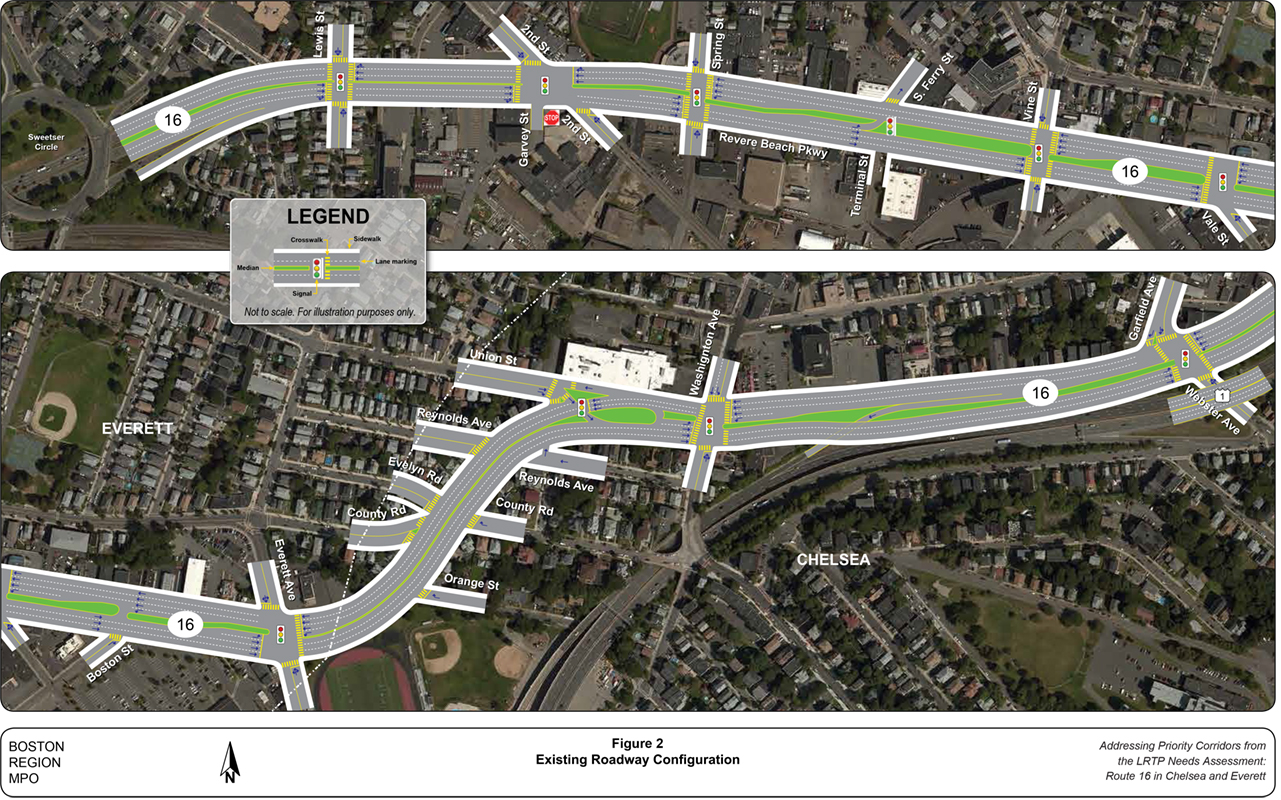
Figure 3
Transportation Equity Map
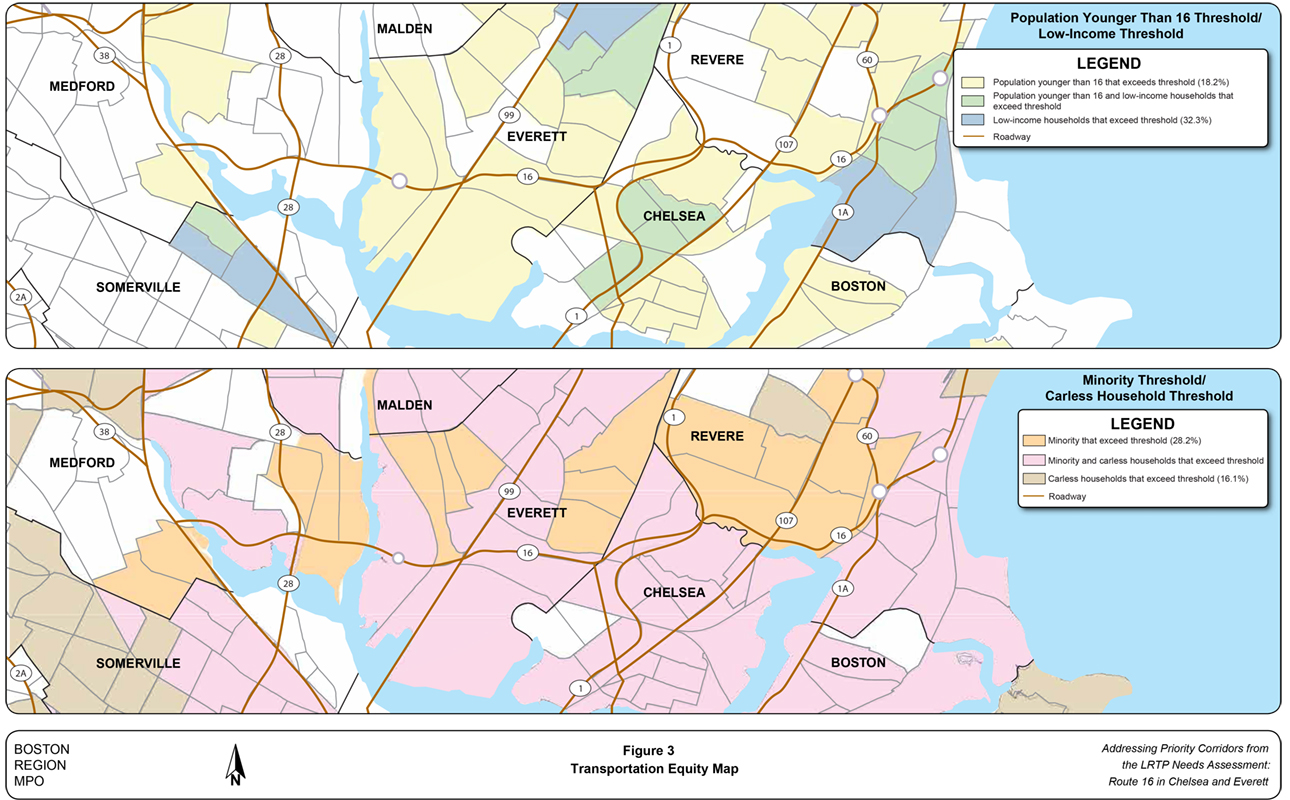
Figure 4
Existing Sidewalk Conditions
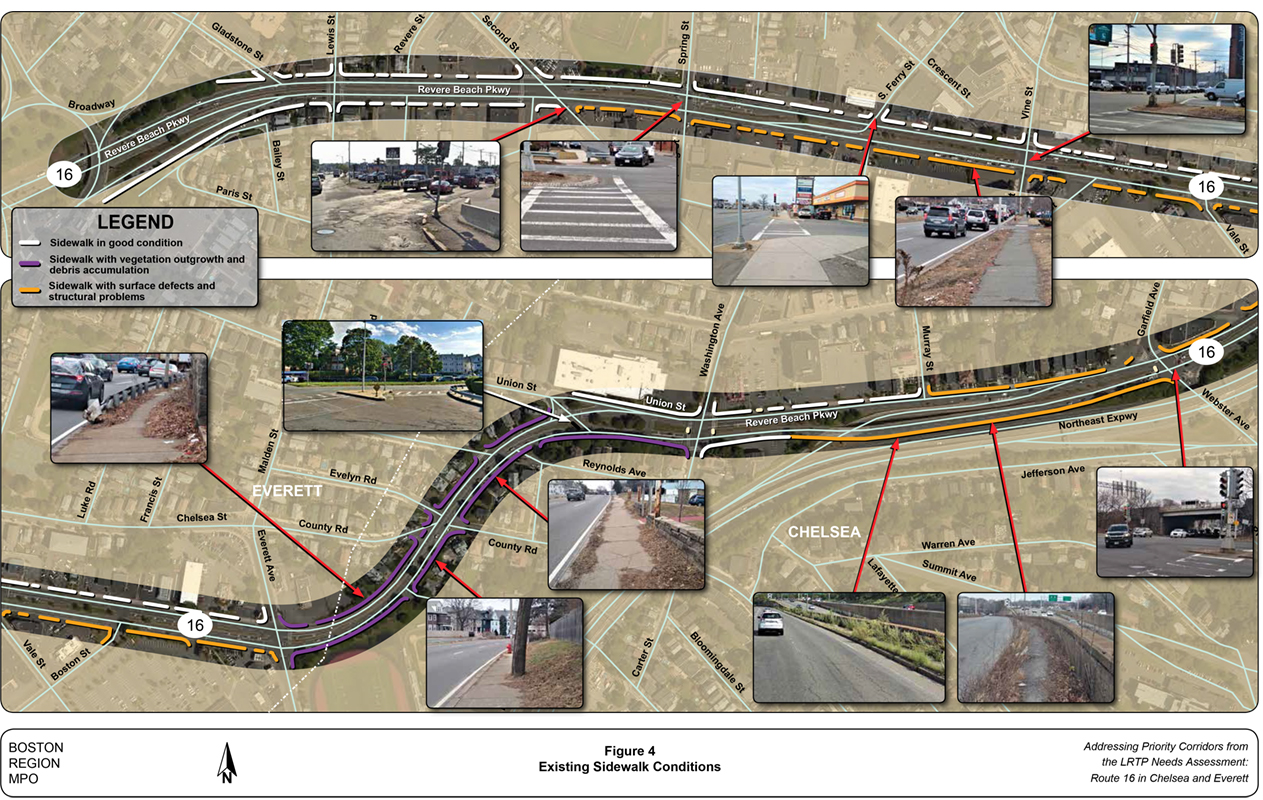
Figure 5
Existing Street Lighting Conditions
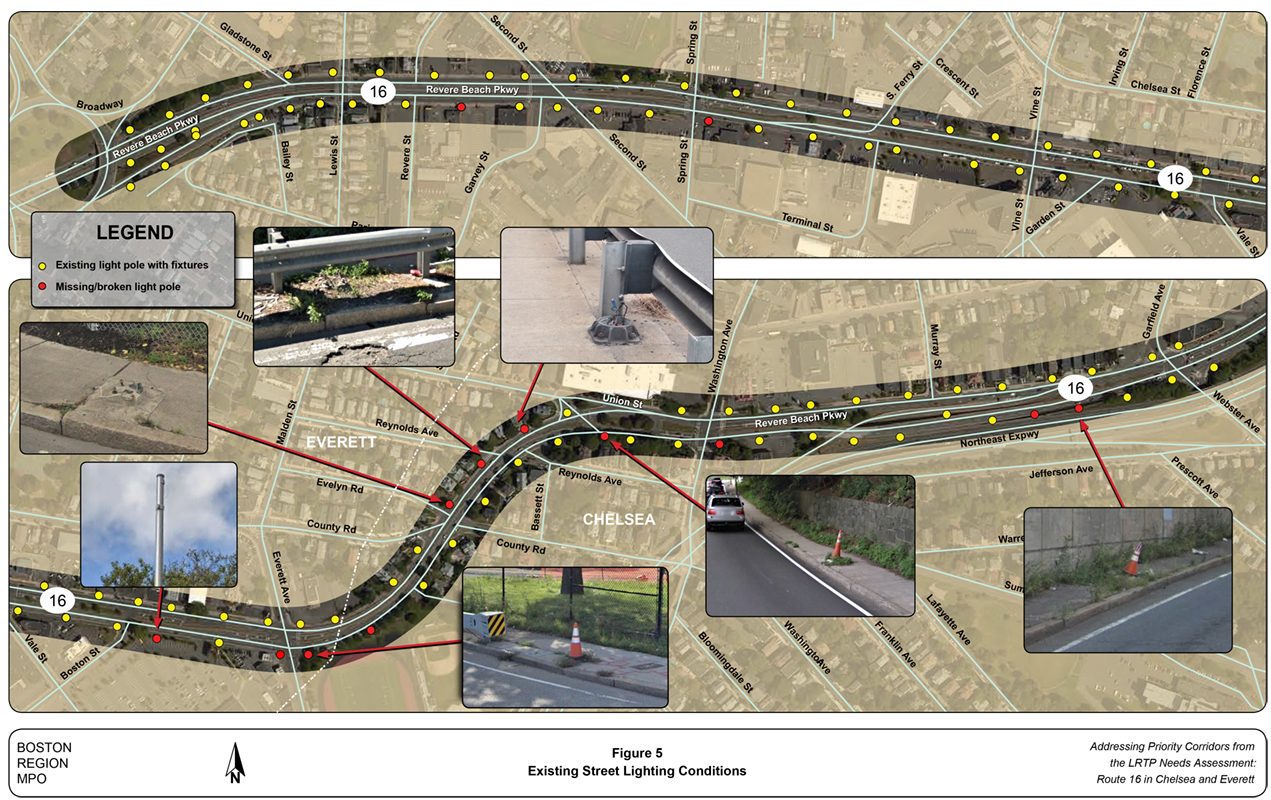
Figure 6
Average Weekday Traffic Volumes
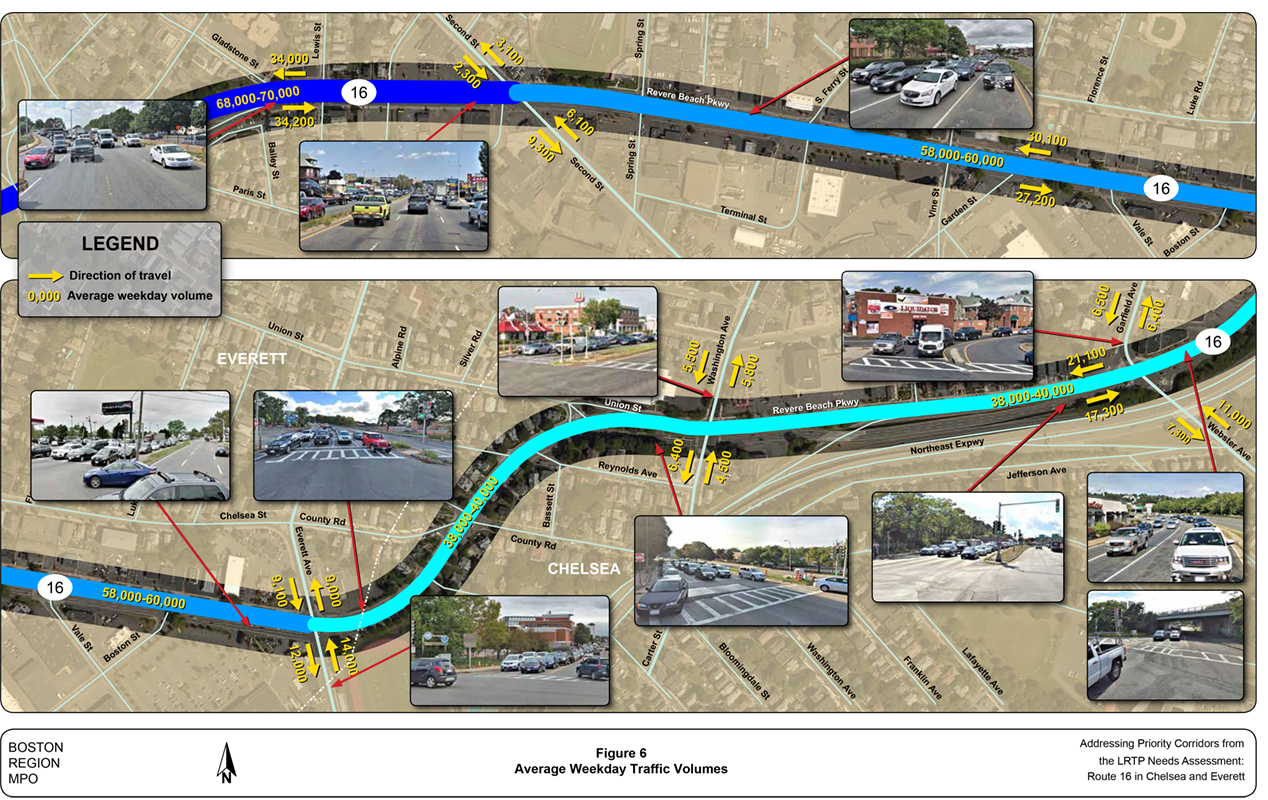
Figure 7
Average Weekday Truck Volumes
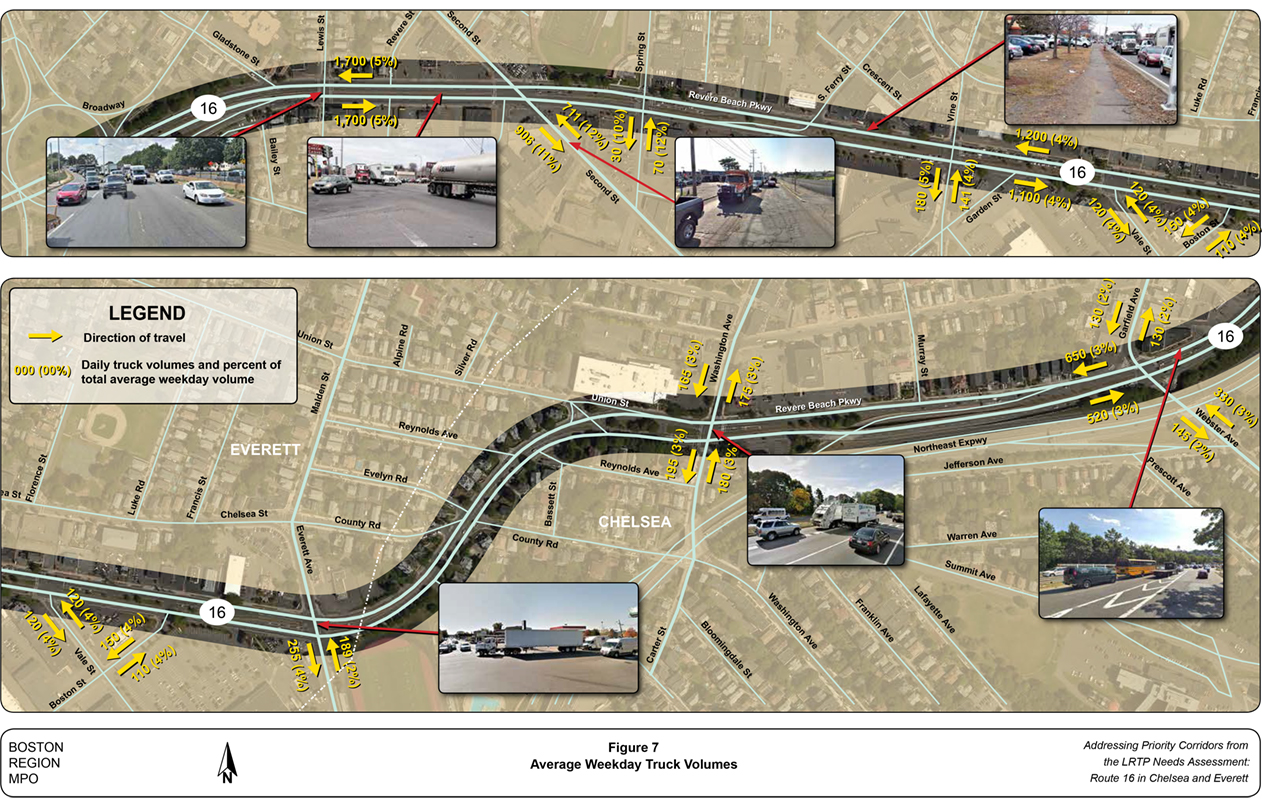
Figure 8
Weekday Peak-Hours Turning Movement Volumes 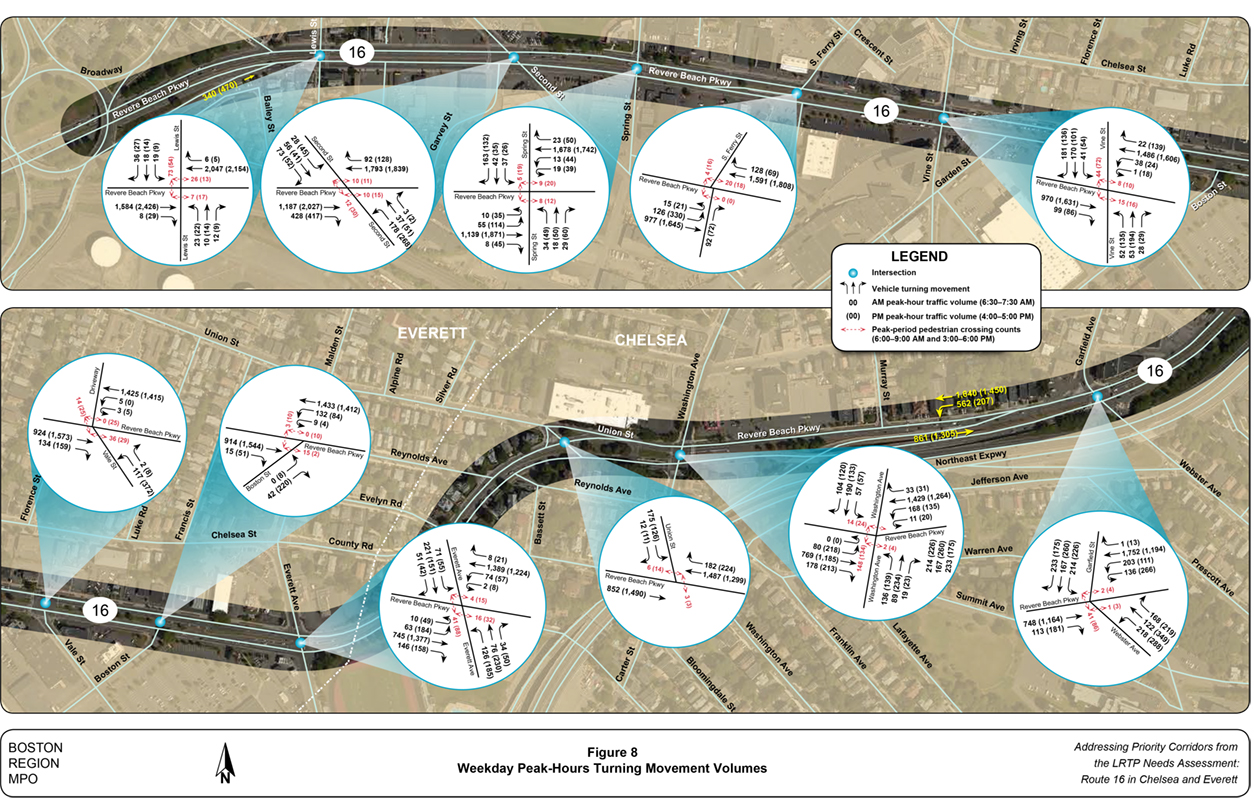
Figure 9
Weekend Midday Peak-Hour Turning Movement Volumes
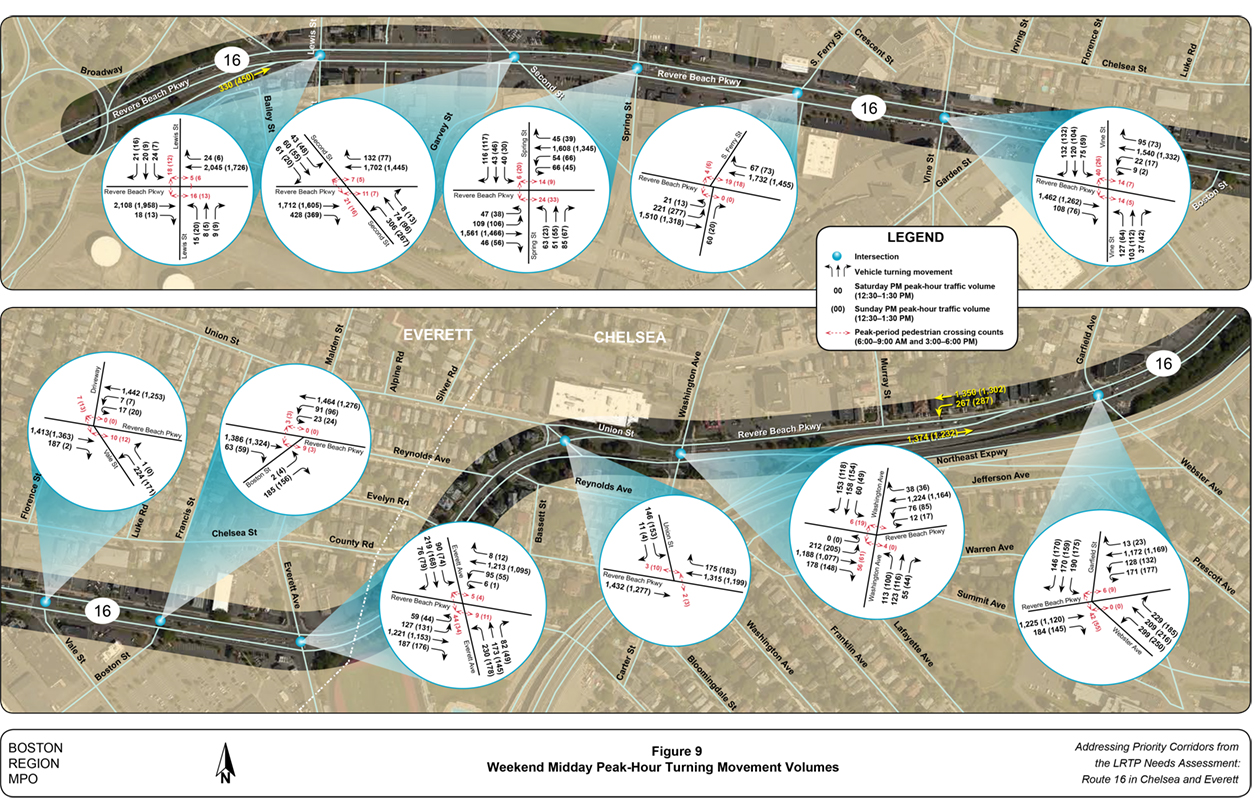
Figure 10
Weekday and Weekend Pedestrian Volumes
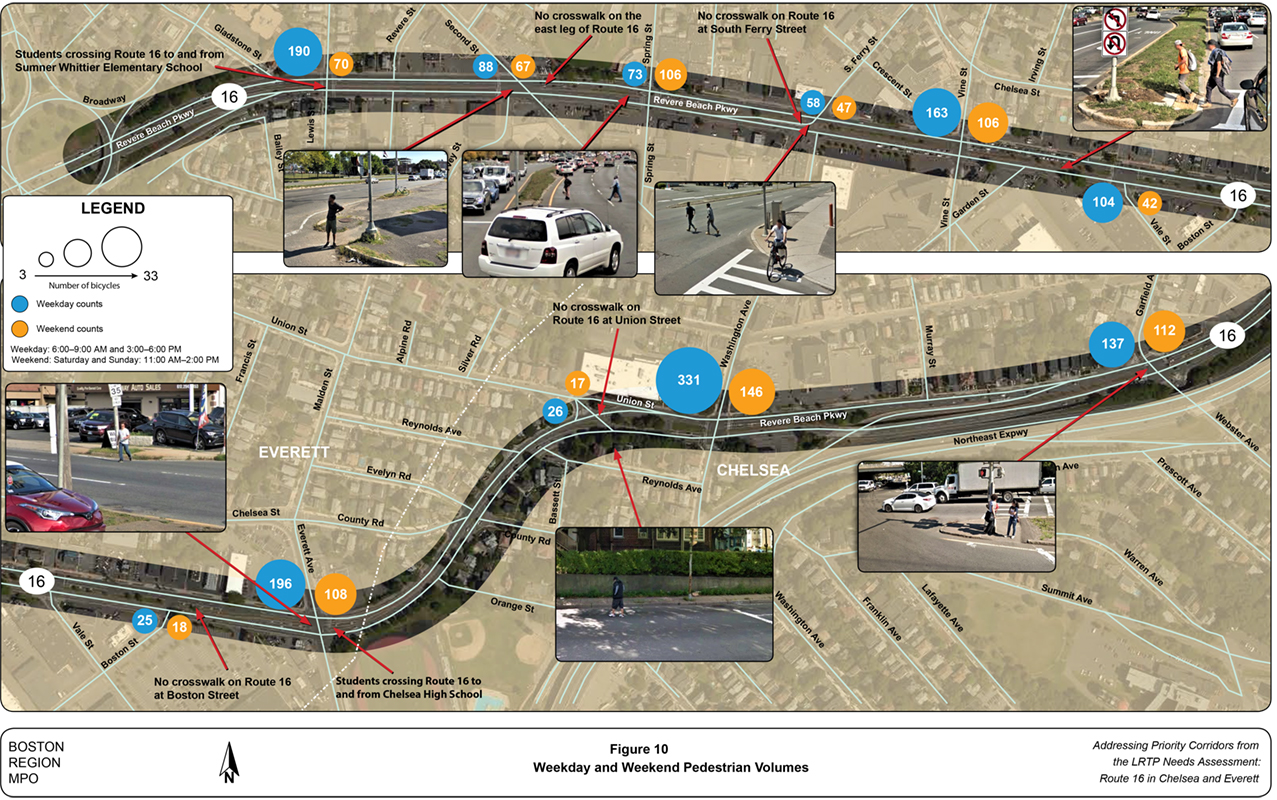
Figure 11
Weekday and Weekend Bicycle-on-Road Volumes
(Excludes Bicycles on Sidewalks)

Figure 12
Spot Speeds and Speed Index Measurements
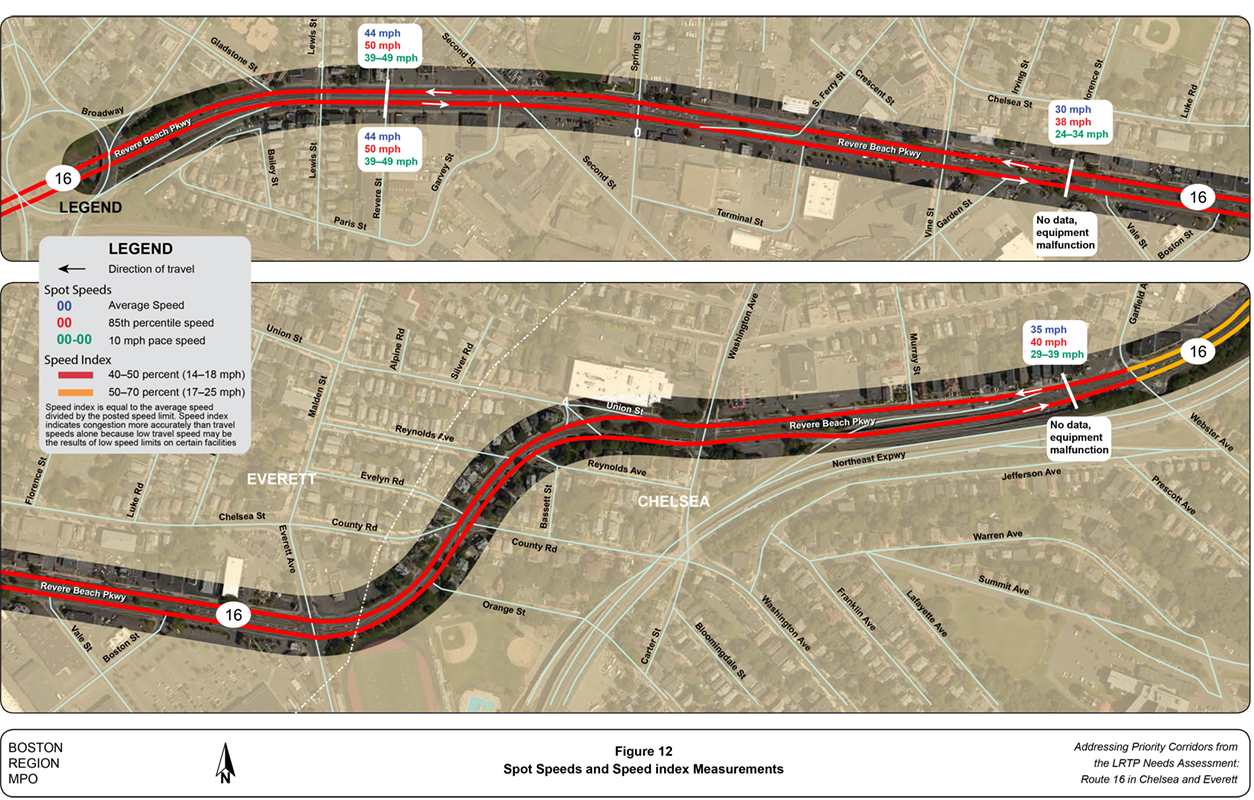
Figure 13
Highway Safety Improvement Program Intersection Crash Clusters
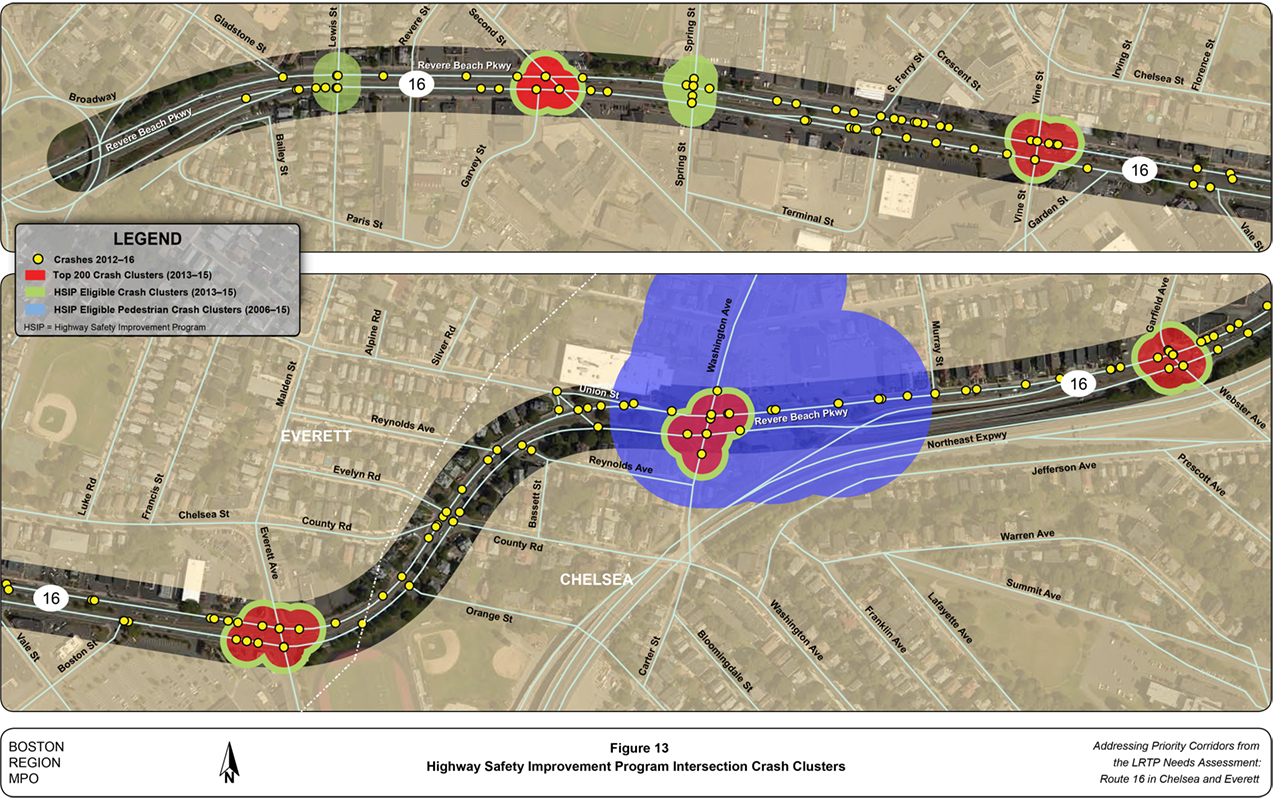
Figure 14
Observed and Predicted Crashes (2012–16) and Safety Improvement Potentials
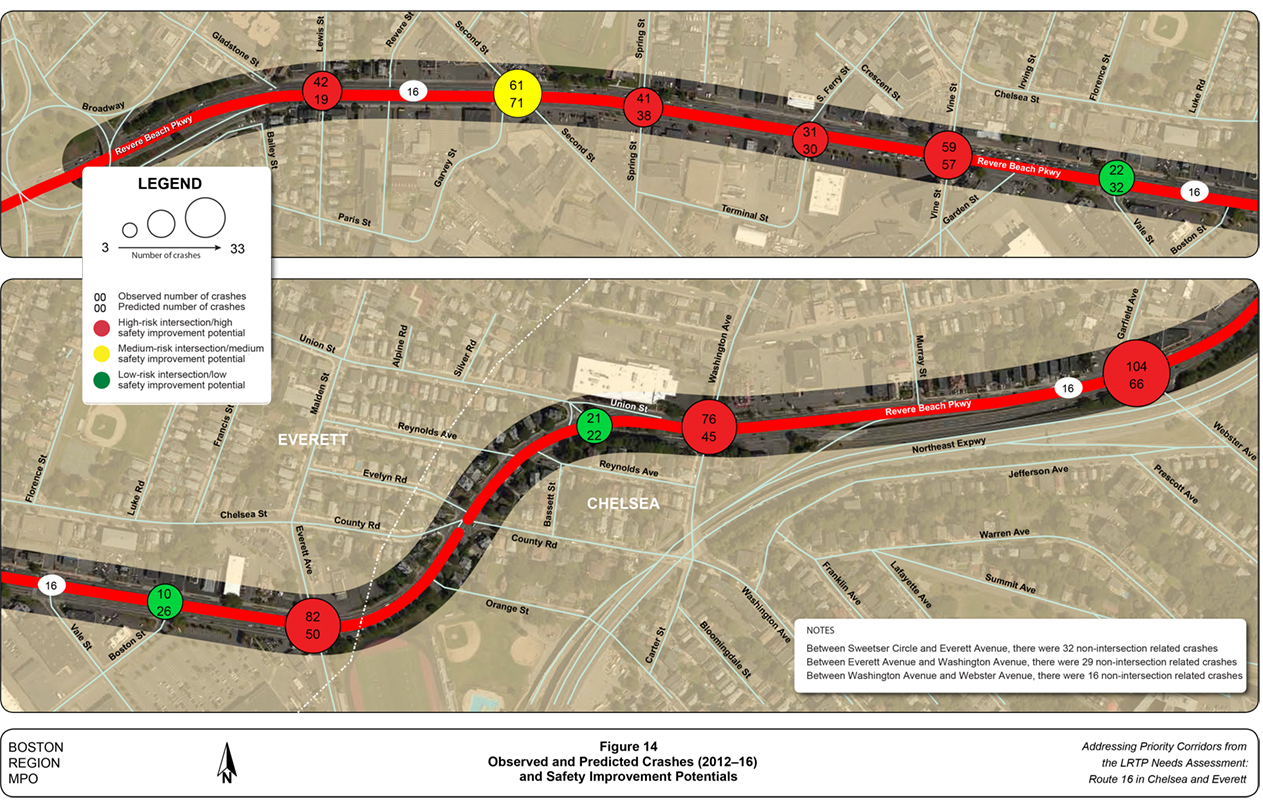
Figure 15
Weekday AM Peak-Hour Level of Service and Delay
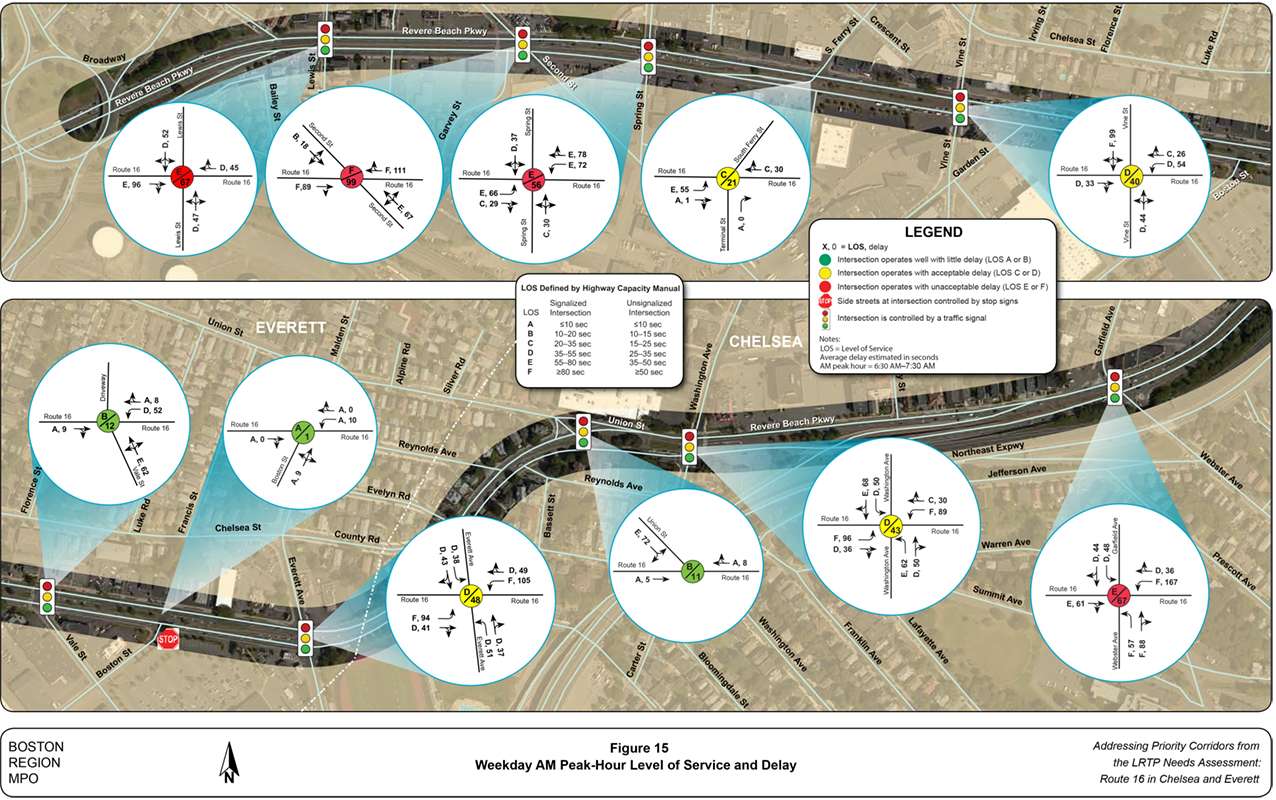
Figure 16
Weekday PM Peak-Hour Level of Service and Delay

Figure 17
Weekend Saturday Midday Peak-Hour Level of Service and Delay
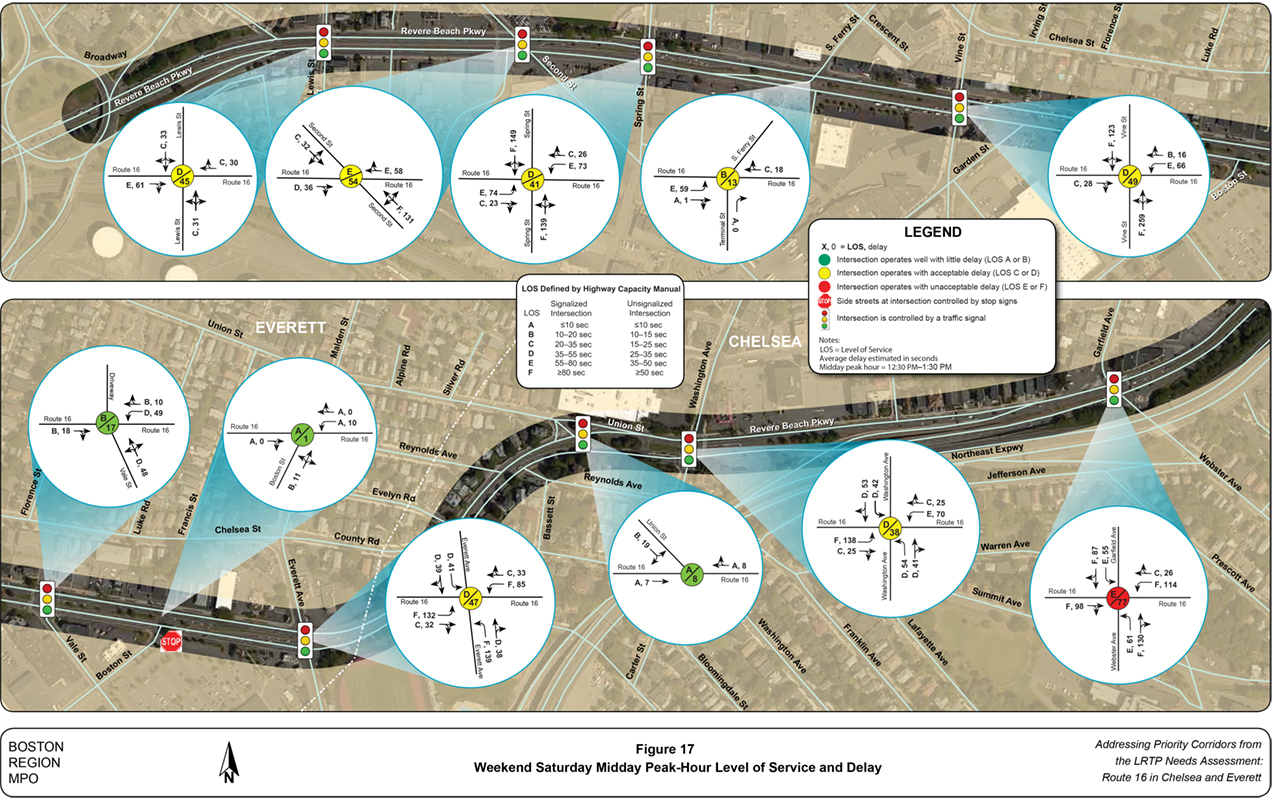
Figure 18
Weekend Sunday Midday Peak-Hour Level of Service and Delay
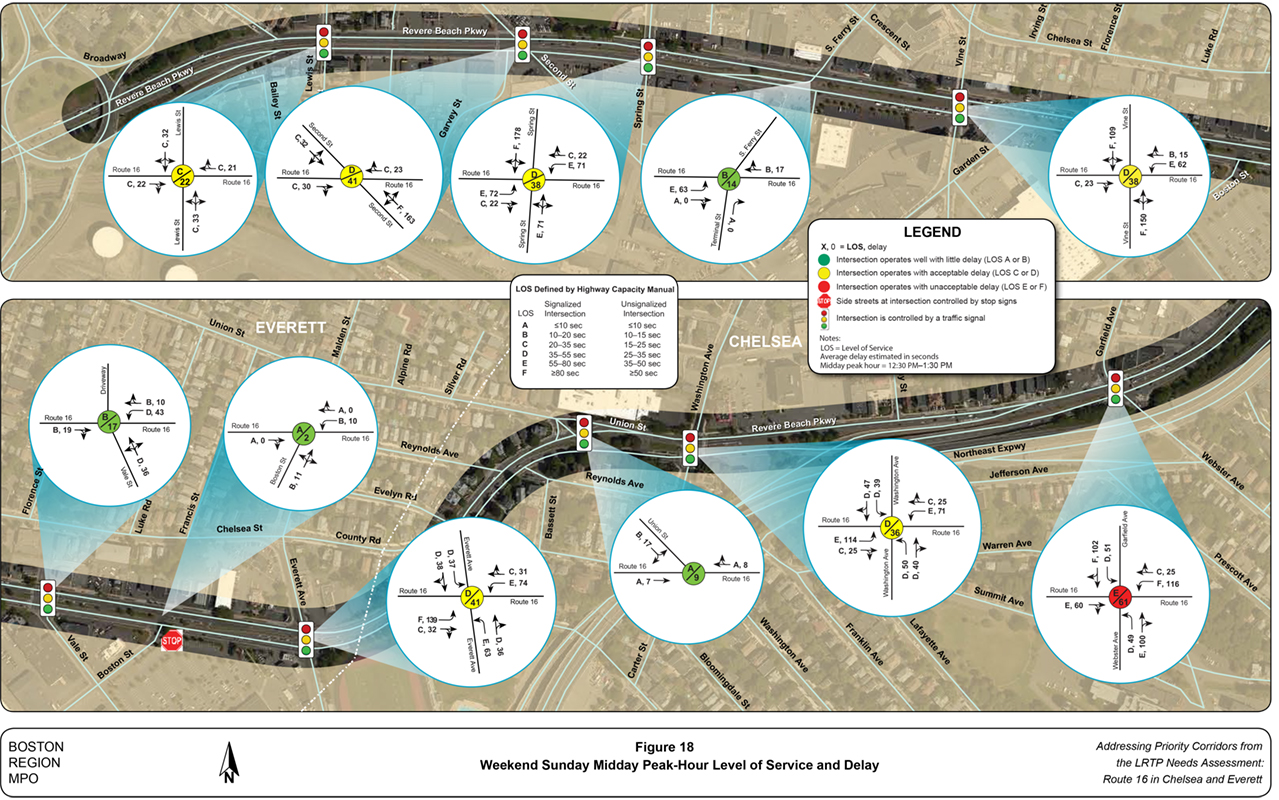
Figure 19
Survey Questions and Number of Respondents
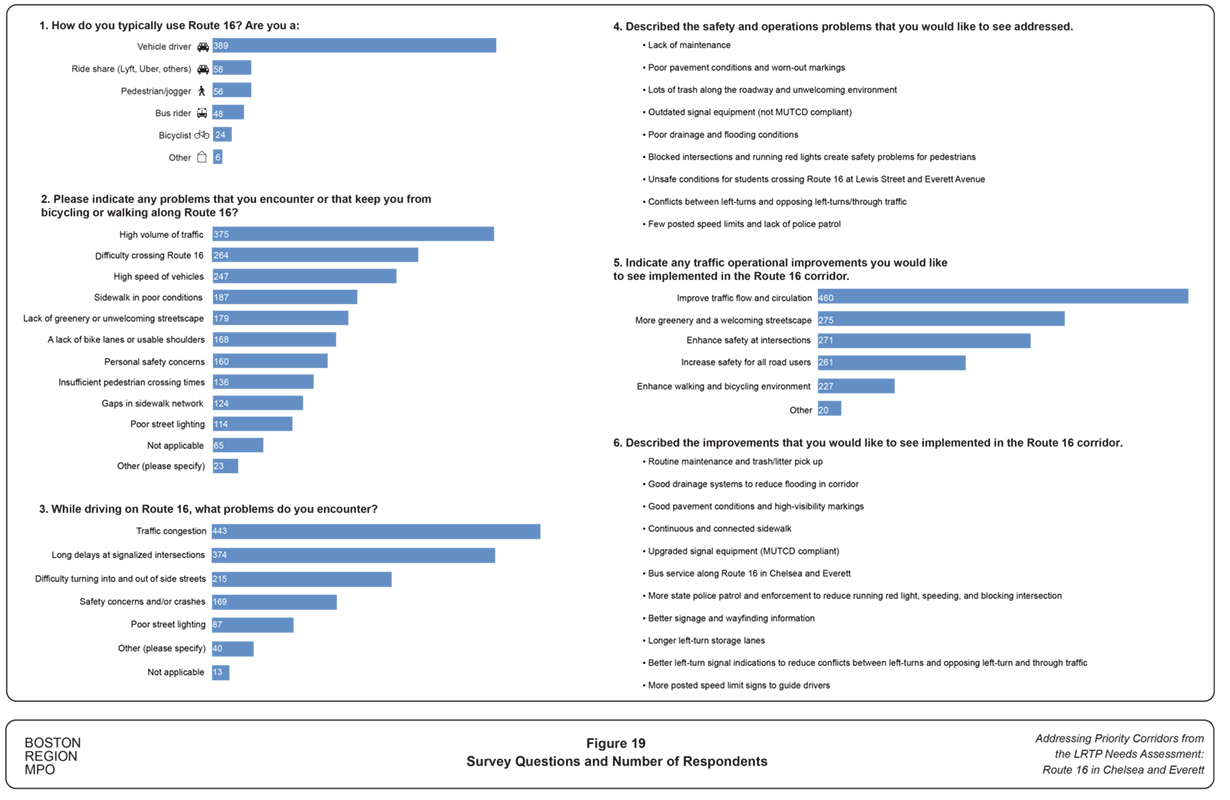
Figure 20
Summary of Problems and Concerns: Lewis Street to South Ferry Street

Figure 21
Summary of Problems and Concerns: Vine Street to Everett Avenue
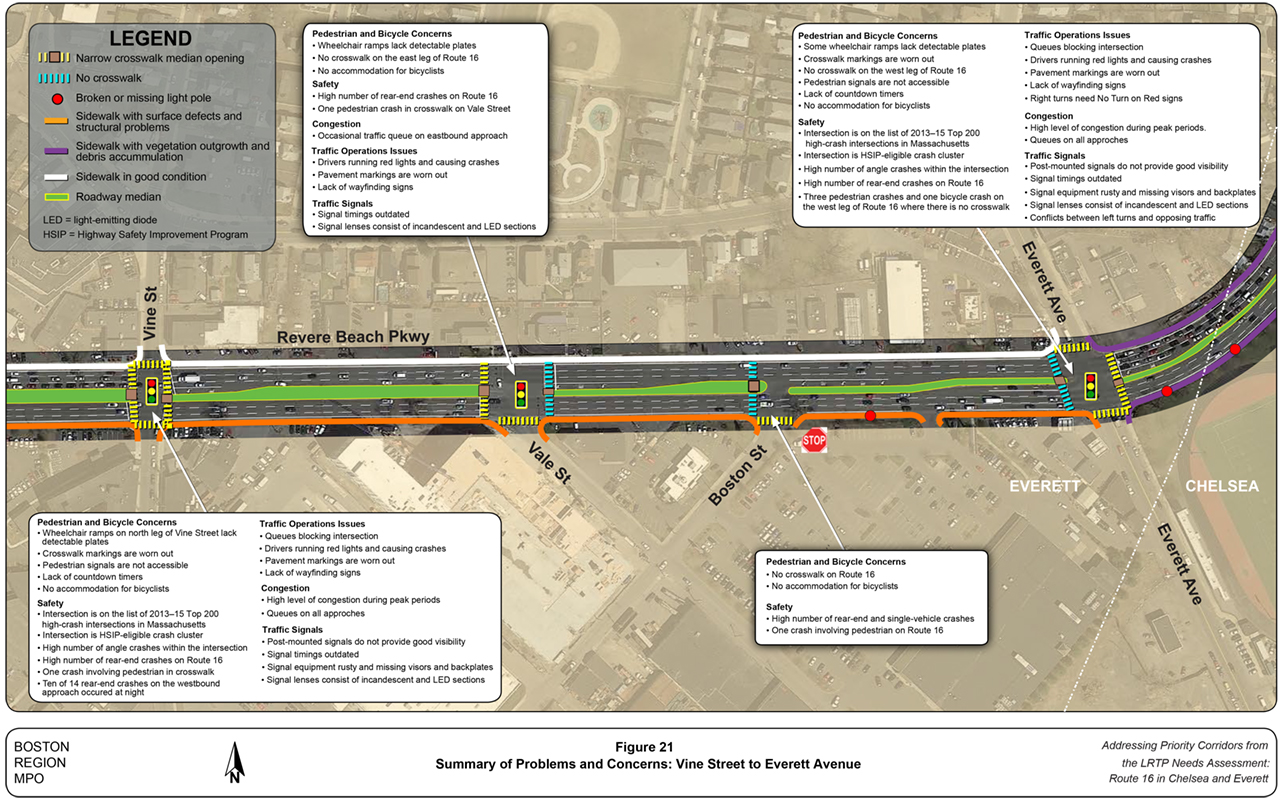
Figure 22
Summary of Problems and Concerns: Everett Avenue to Washington Avenue
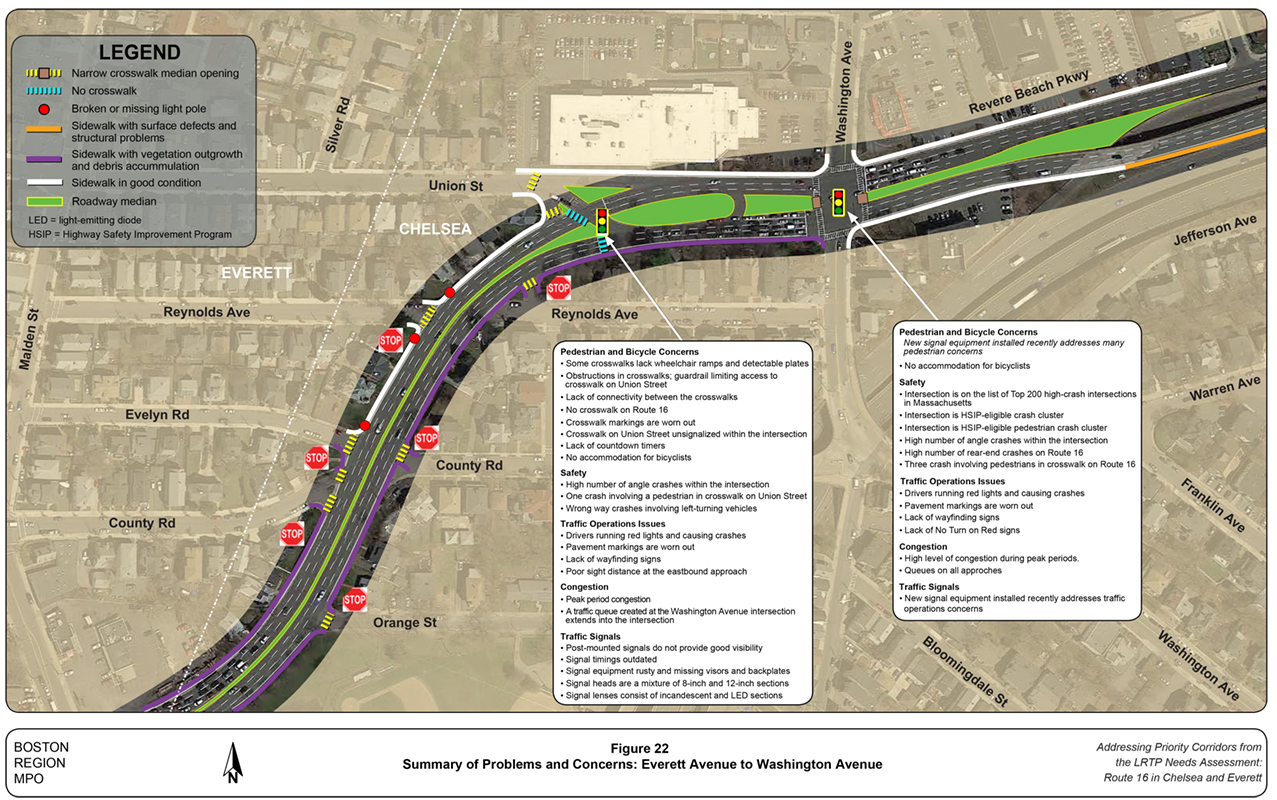
Figure 23
Summary of Problems and Concerns: Washington Avenue to Route 1
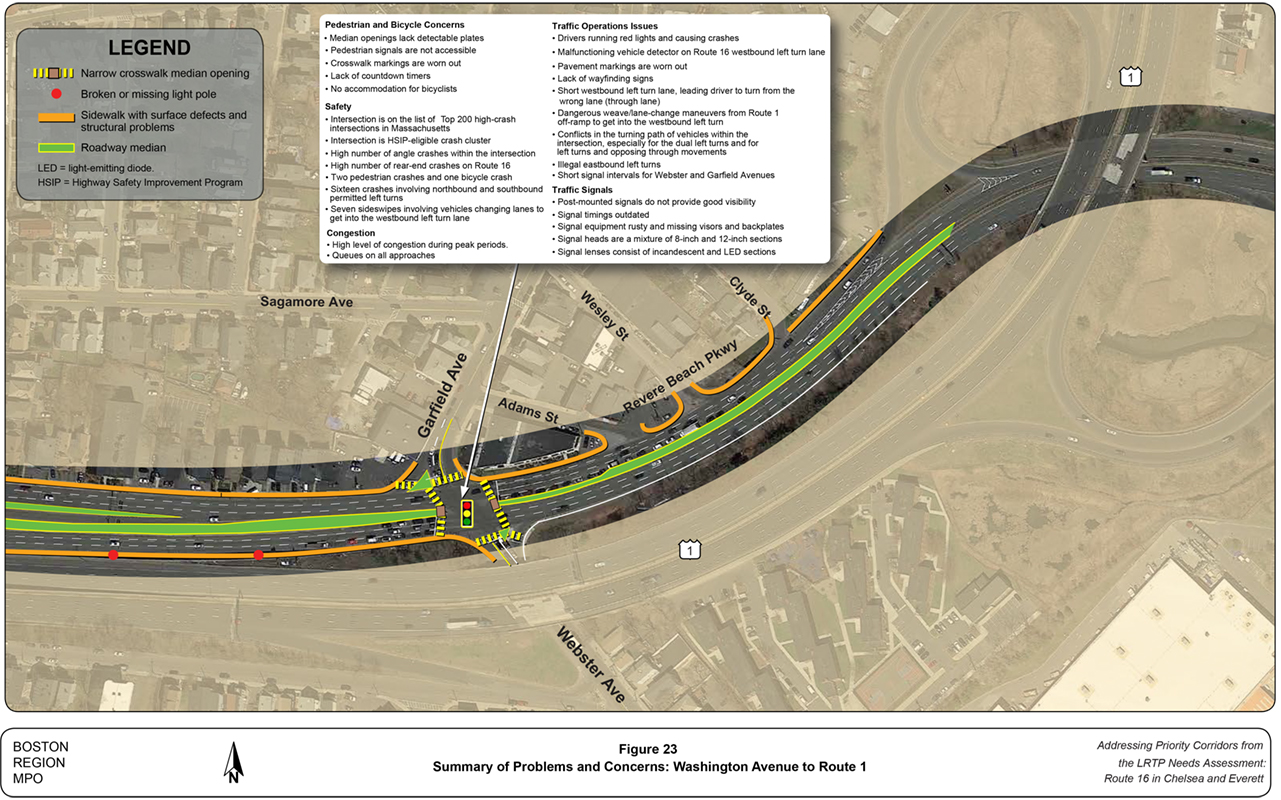
Figure 24
Short- and Medium-Term Improvements: Lewis Street to South Ferry Street
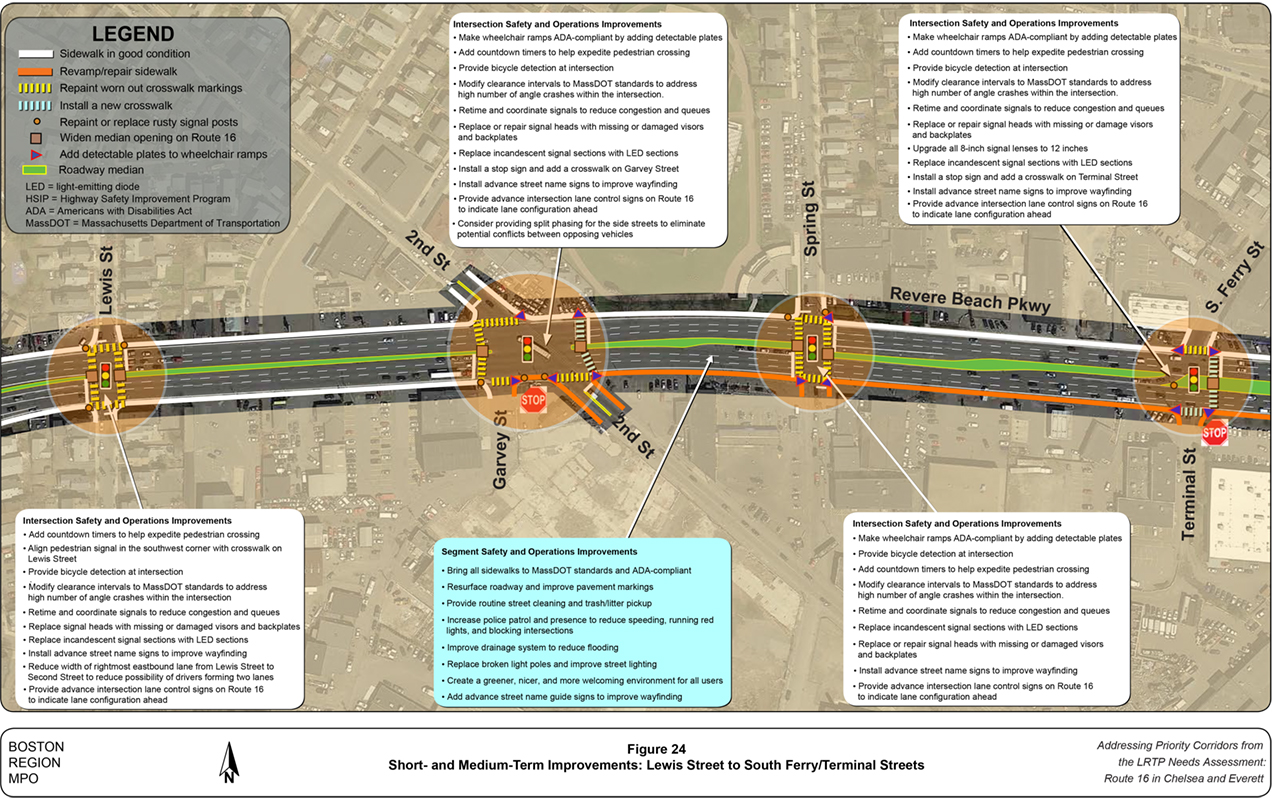
Figure 25
Short- and Medium-Term Improvements: Vine Street to Everett Avenue
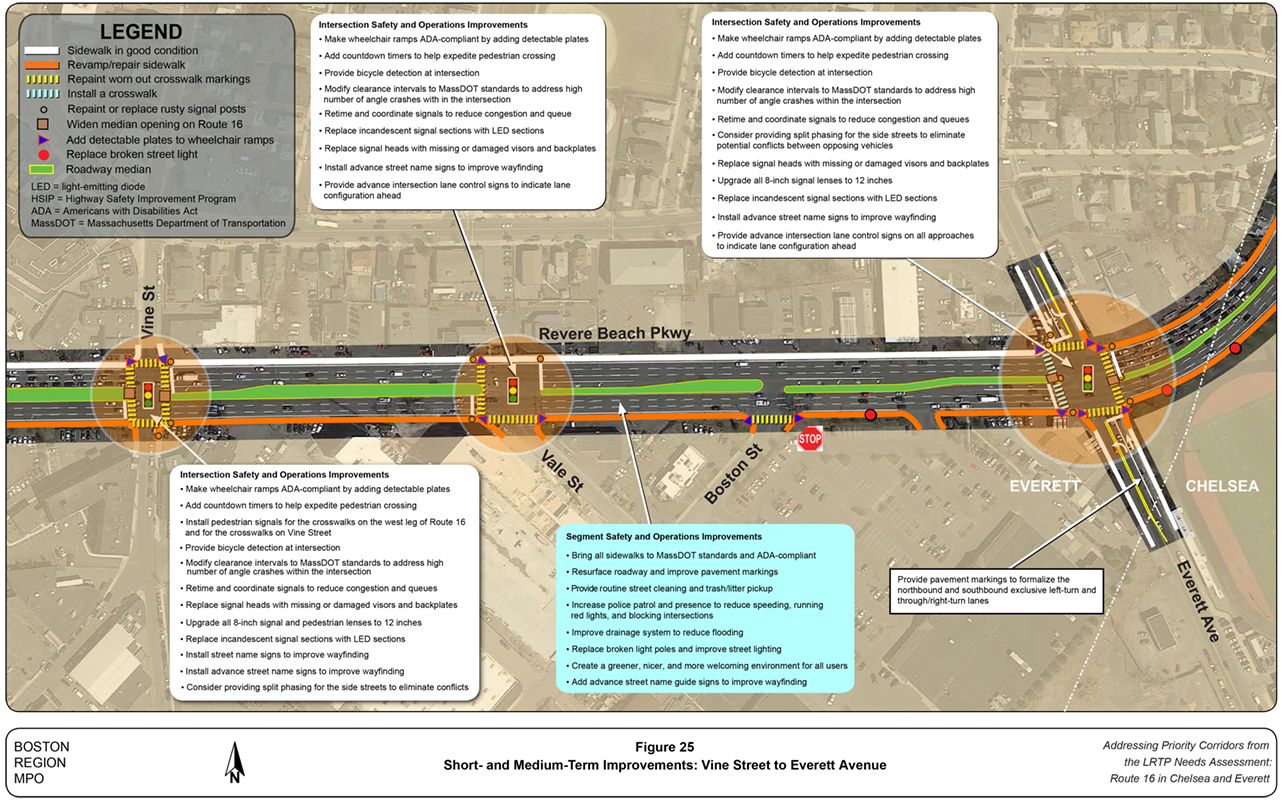
Figure 26
Short- and Medium-Term Improvements: Everett Avenue to Washington Avenue

Figure 27
Short- and Medium-Term Improvements: Washington Avenue to Route 1
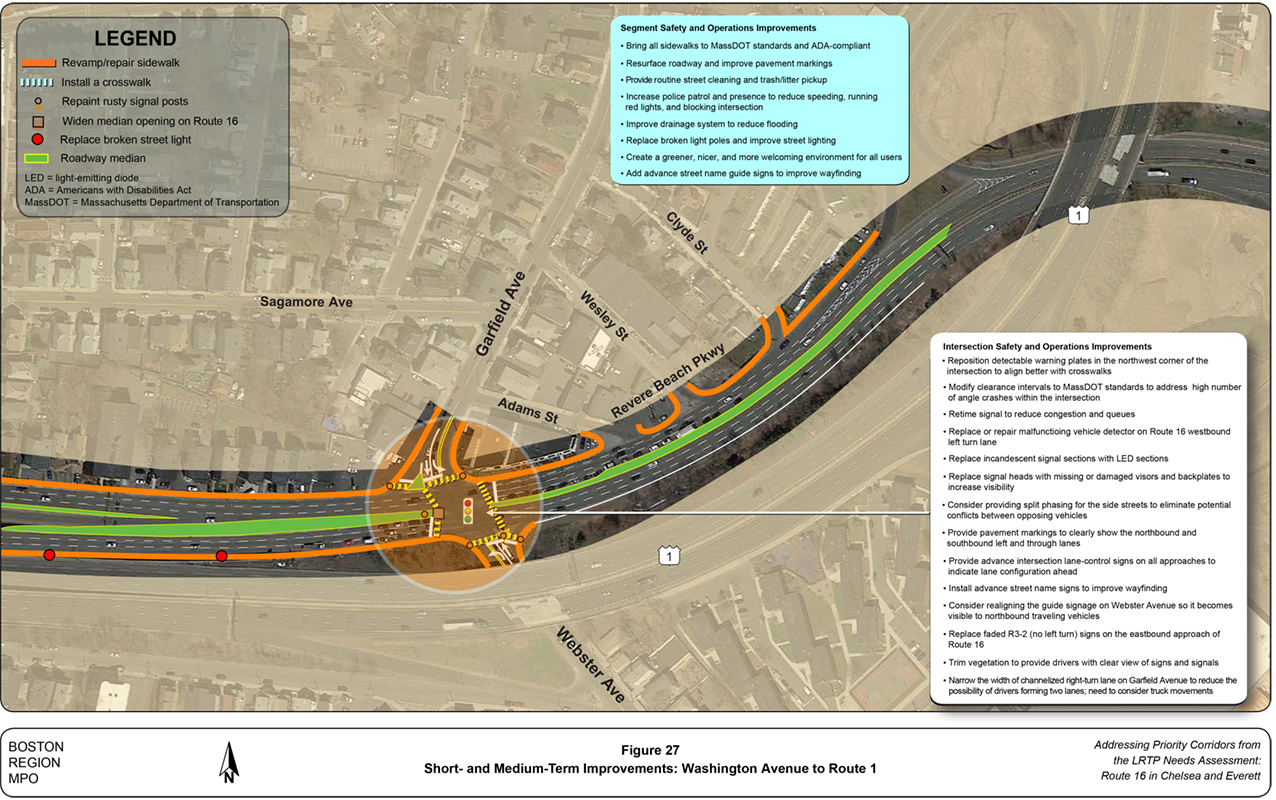
Figure 28
Weekday AM Peak-Hour Level of Service and Delay
Short-Term Traffic Signal Retiming and Coordination Improvements
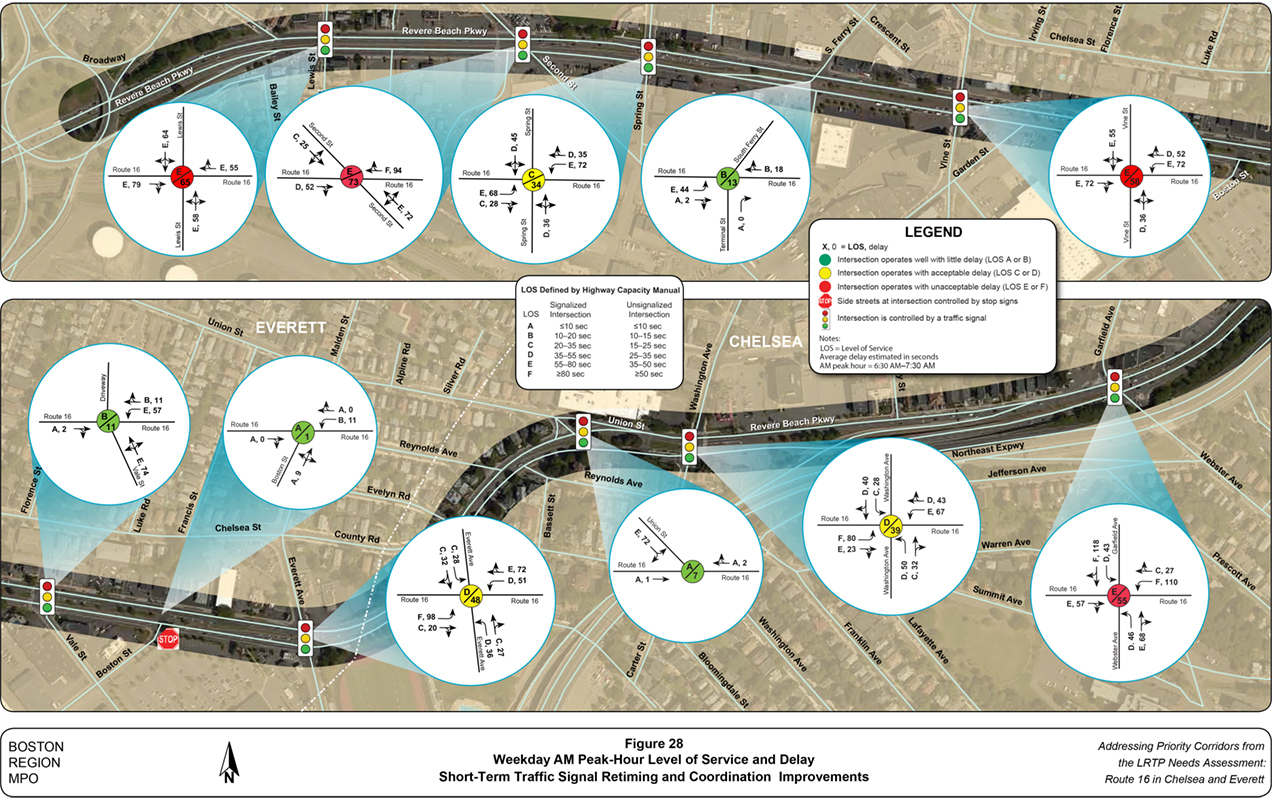
Figure 29
Weekday PM Peak-Hour Level of Service and Delay
Short-Term Traffic Signal Retiming and Coordination Improvements
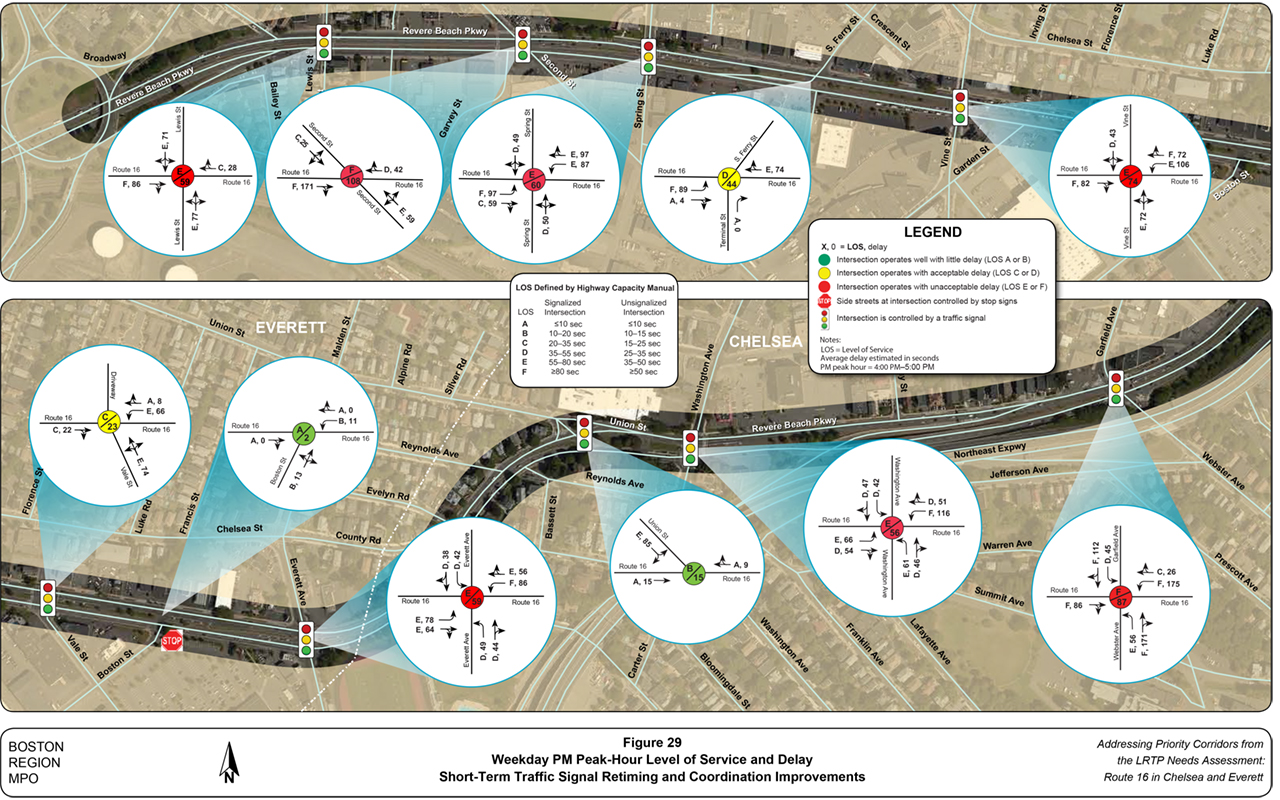
Figure 30
Weekend Saturday Midday Peak-Hour Level of Service and Delay
Short-Term Traffic Signal Retiming and Coordination Improvements
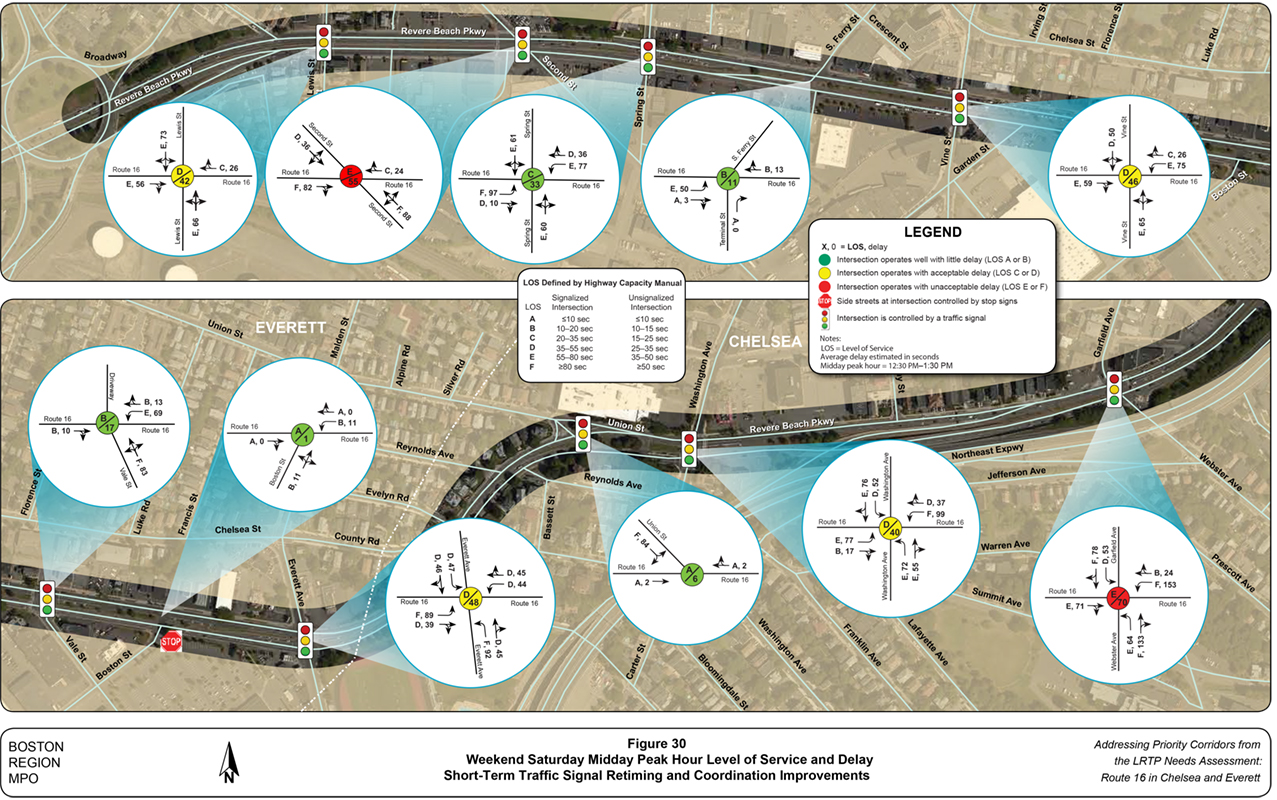
Figure 31
Weekend Sunday Midday Peak-Hour Level of Service and Delay
Short-Term Traffic Signal Retiming and Coordination Improvements
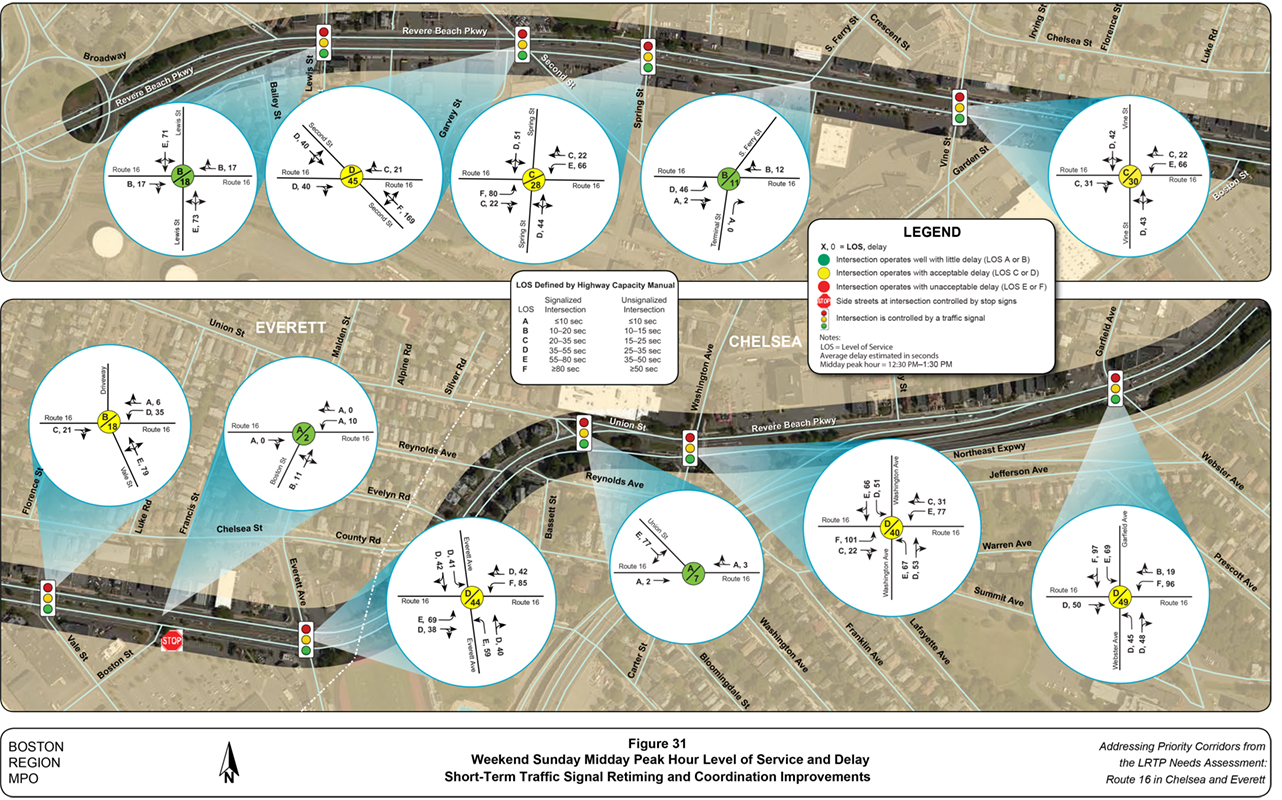
Figure 32
Long-Term Improvements: Lewis Street to South Ferry Street
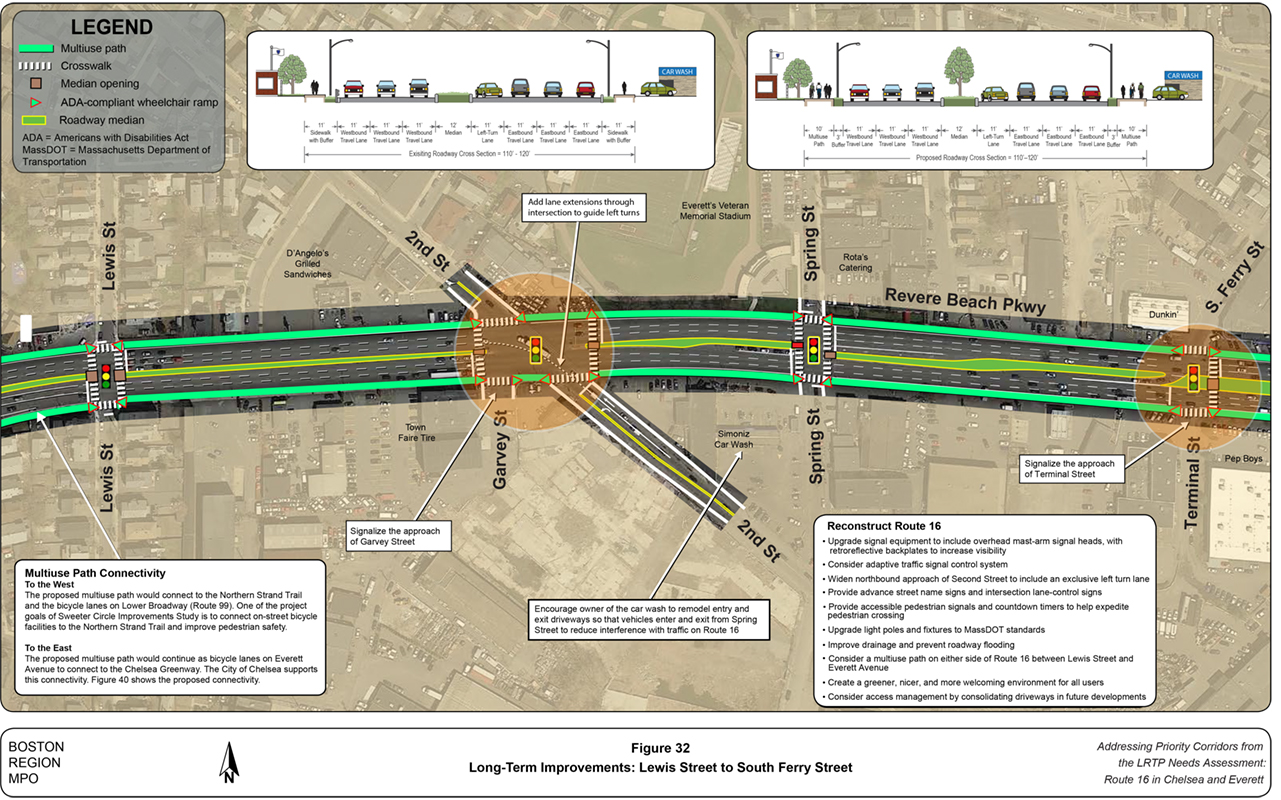
Figure 33
Long-Term Improvements: Vine Street to Everett Avenue
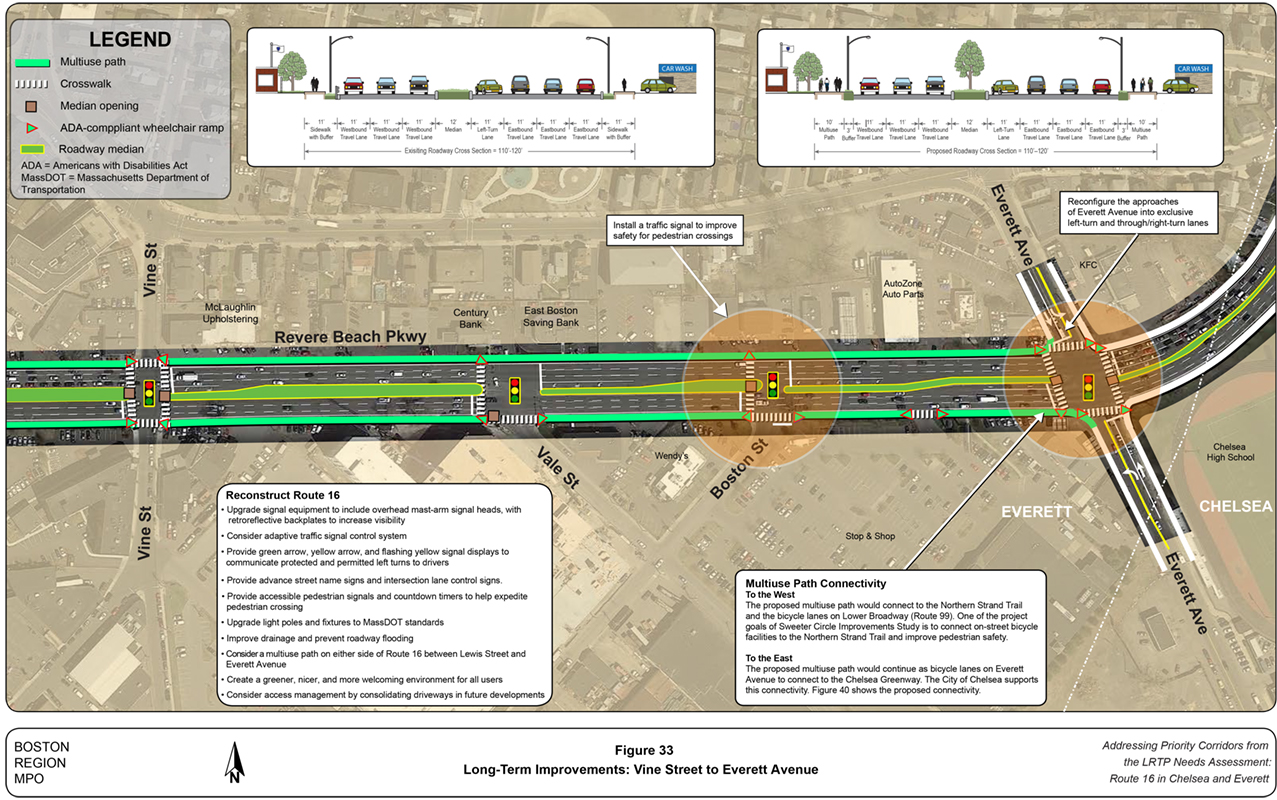
Figure 34
Long-Term Improvements: Everett Avenue to Washington Avenue
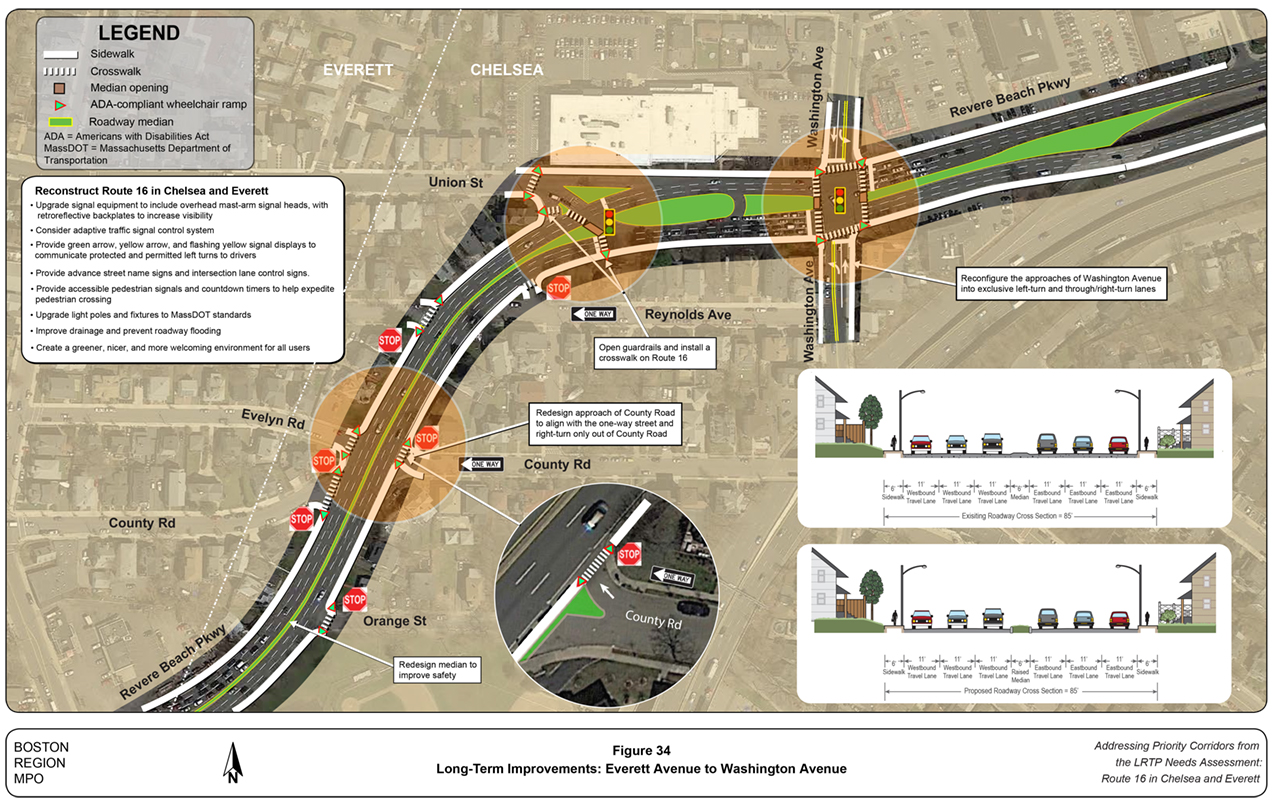
Figure 35
Long-Term Improvements: Washington Avenue to Route 1
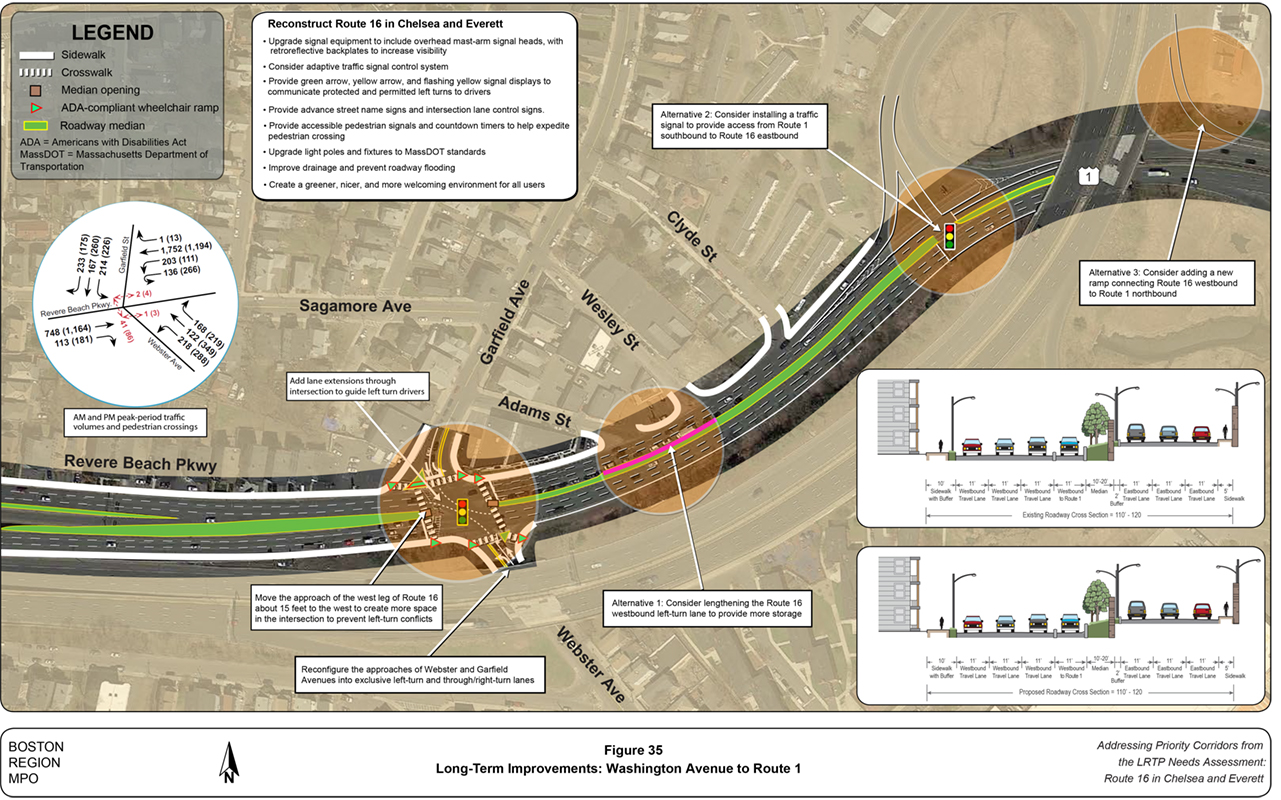
Figure 36
Weekday AM Peak-Hour Level of Service and Delay
Long-Term Improvements
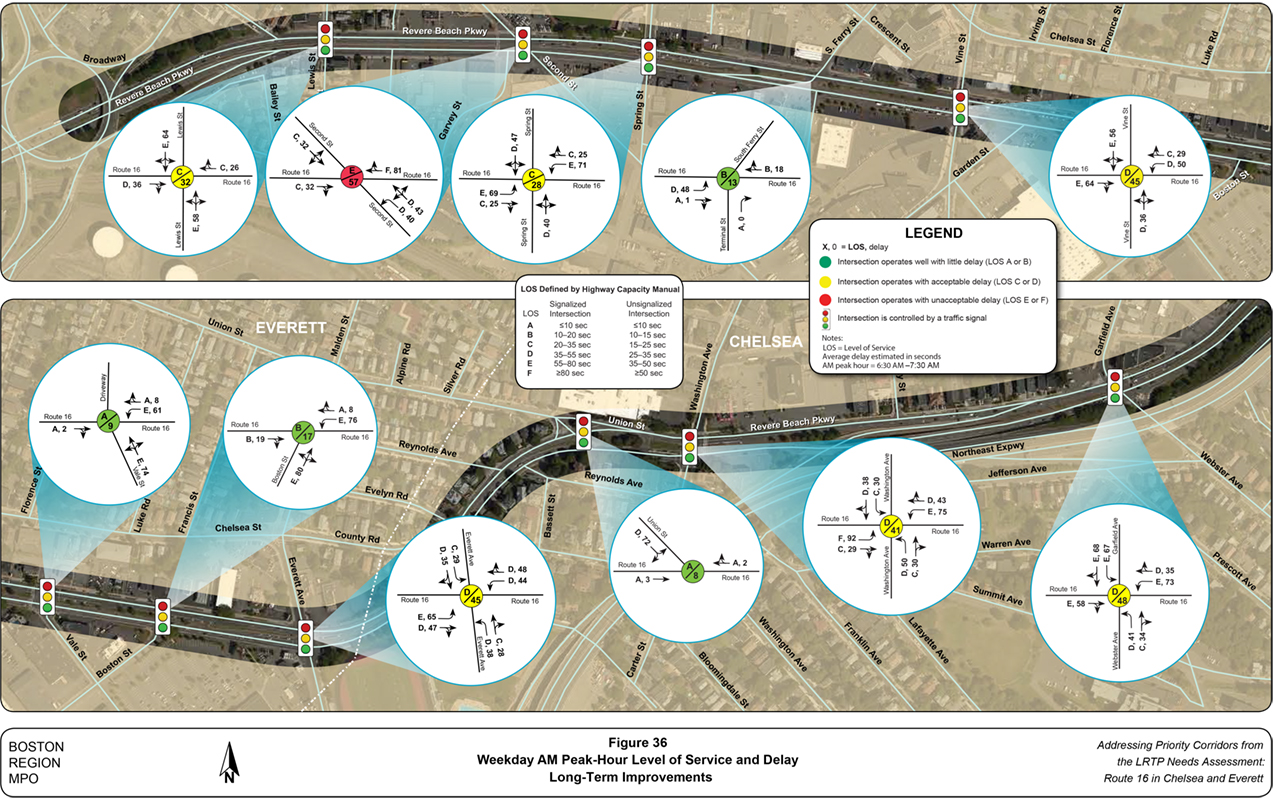
Figure 37
Weekday PM Peak-Hour Level of Service and Delay
Long-Term Improvements
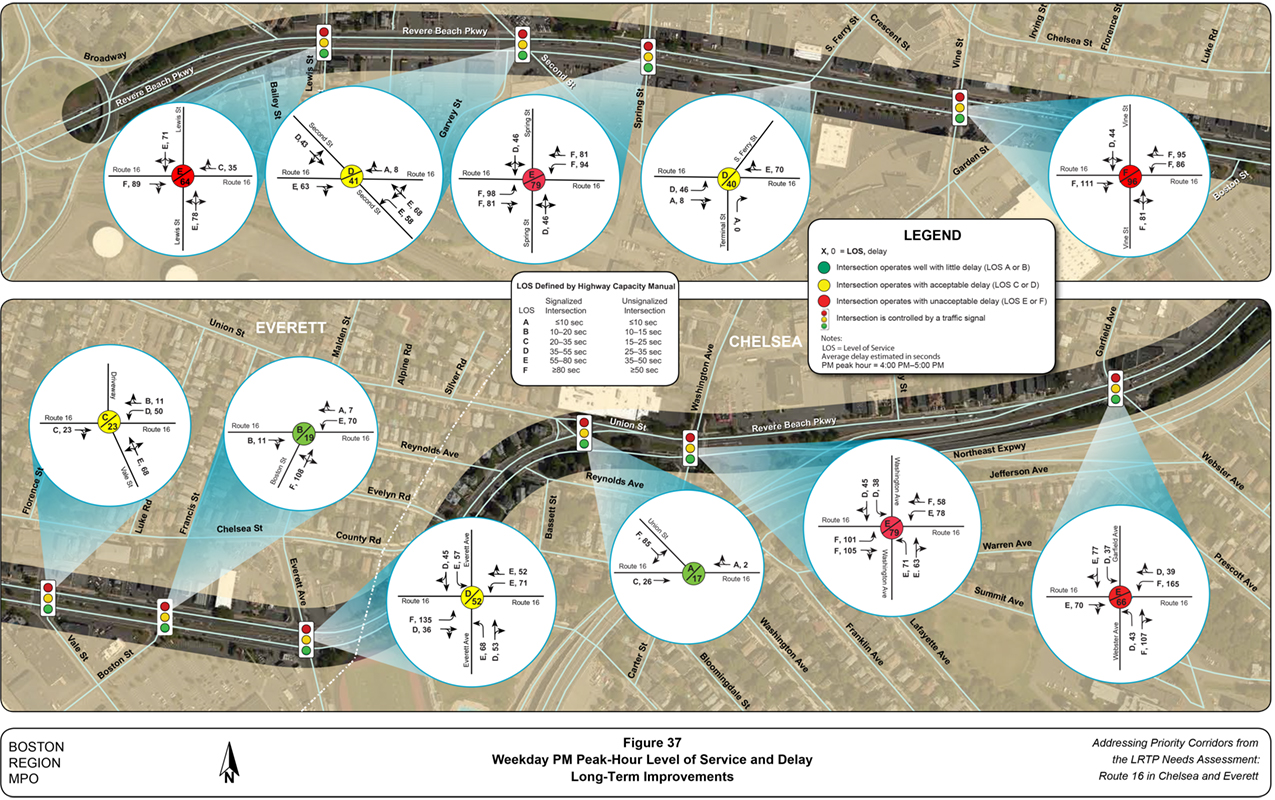
Figure 38
Weekend Saturday Midday Peak-Hour Level of Service and Delay
Long-Term Improvements
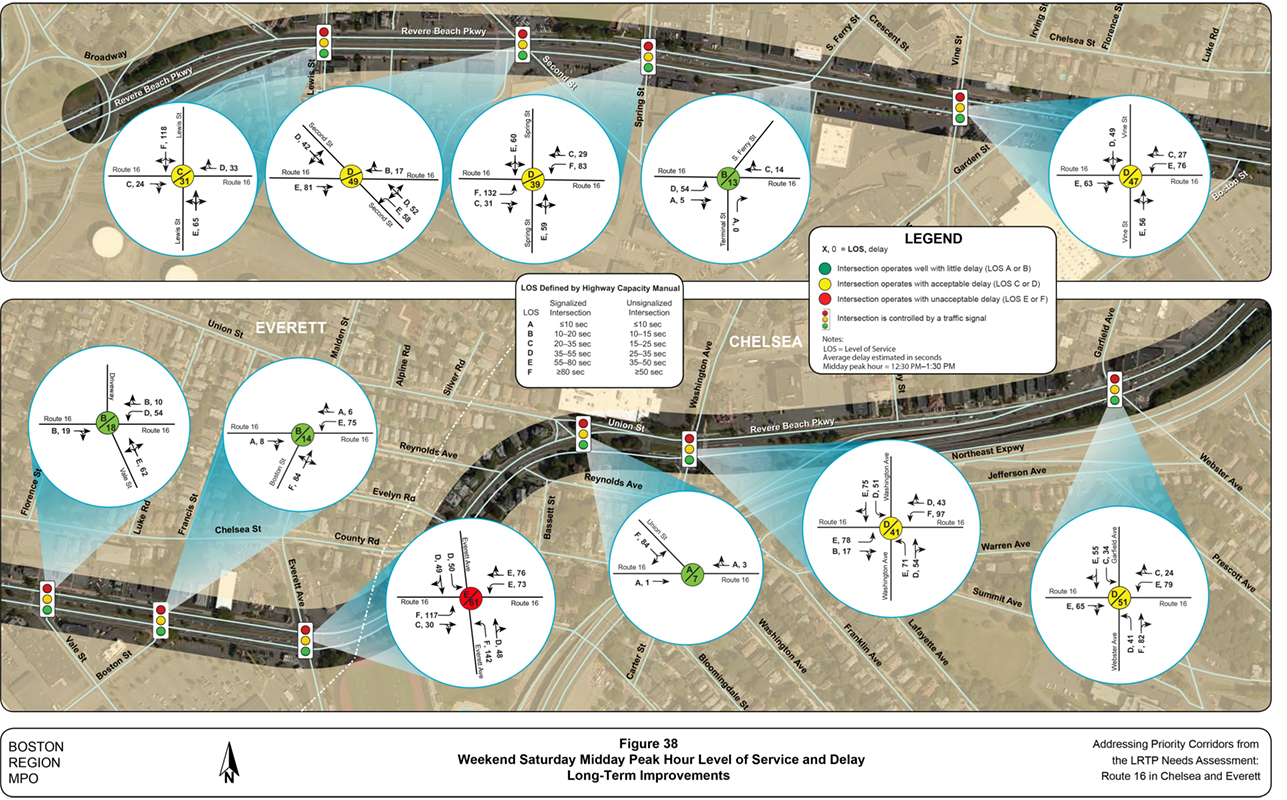
Figure 39
Weekend Sunday Midday Peak-Hour Level of Service and Delay
Long-Term Improvements
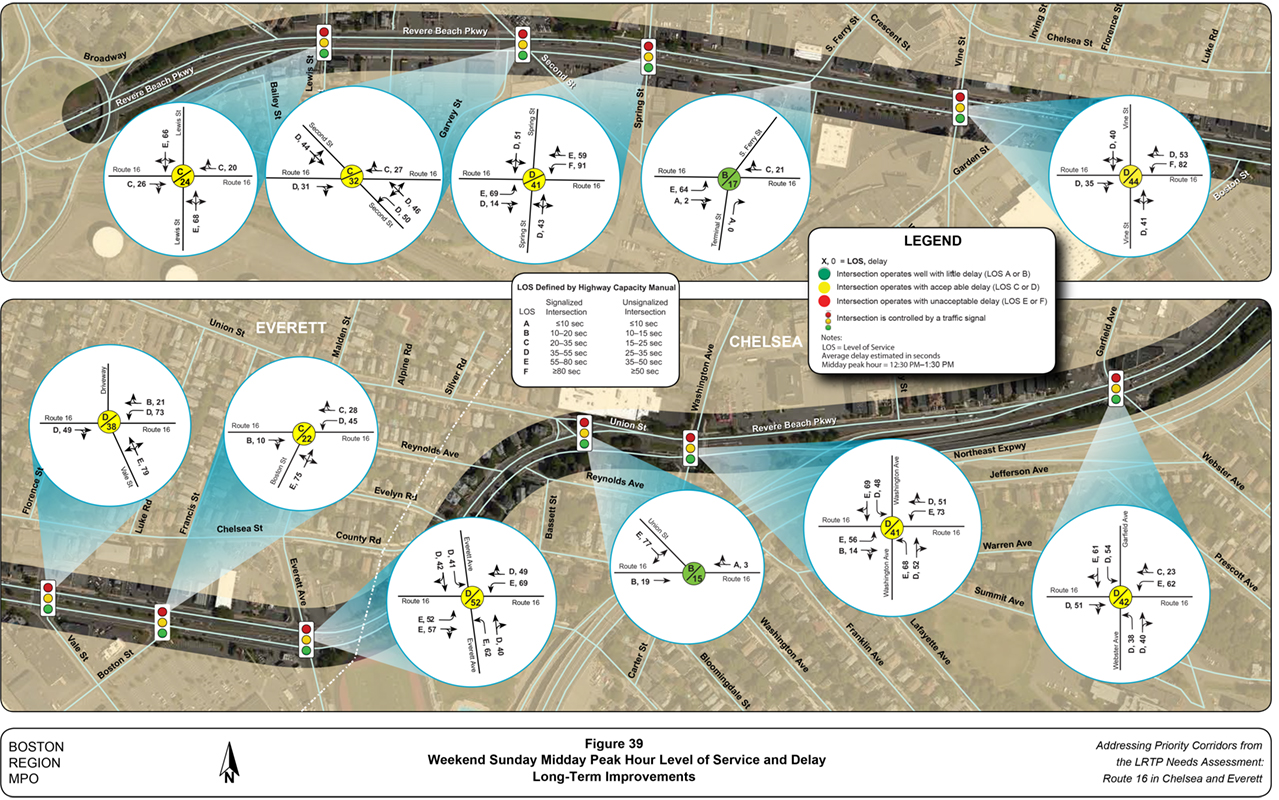
Figure 40
Proposed Long-Term Pedestrian and Bicycle Improvements
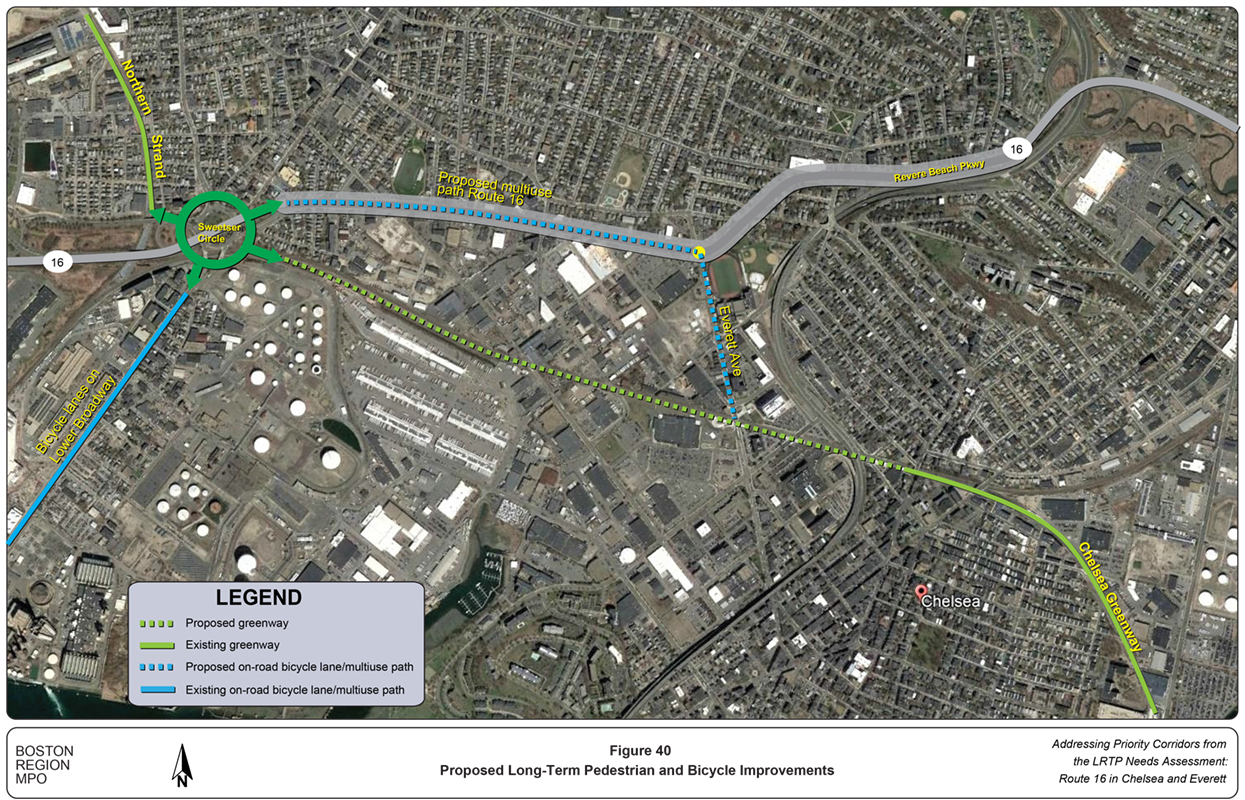
Figure 41
Long-Term Transit Strategies
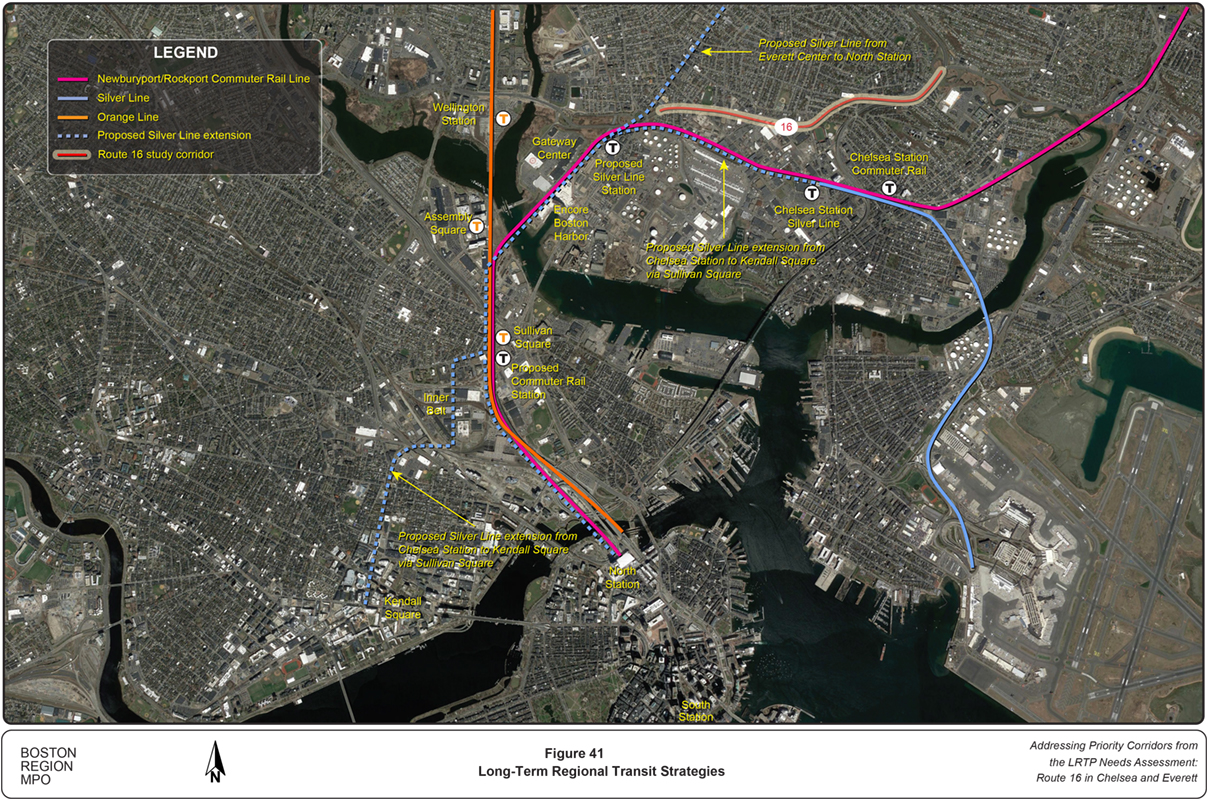
1 An HSIP crash cluster is a location in which the number and severity of crashes—as measured on the Equivalent Property Damage Only (EPDO) index—ranks the location among the top five percent of crash clusters in the region. The EPDO method assigns weighted values to each crash based on whether the crash resulted in property damage (unweighted), injury (weighted by 5), or a fatality (weighted by 10).
2 Boston Region Metropolitan Planning Organization, Charting Progress to 2040: The New Long-Range Transportation Plan of the Boston Region Metropolitan Planning Organization, endorsed by the Boston Region MPO on July 30, 2015.
3 Boston Region Metropolitan Planning Organization, Unified Planning Work Program, Federal Fiscal Year 2017, endorsed by the Boston Region Metropolitan Planning Organization on July 28, 2016.
4 Safety Conditions: The location has a higher-than-average crash rate for its functional class; contains a crash cluster that makes it eligible for HSIP funding; contains a crash location on MassDOT Highway Division’s Top High Crash Locations Report; or has a significant number of pedestrian and bicycle crashes (two or more per mile).
5 Congested Conditions: The travel time index is at least 1.3. The travel time index is the ratio of the peak-period travel time to the free-flow travel time.
6 Multimodal Significance: The roadway carries one or more bus routes or is adjacent to a transit stop or station; the roadway supports bicycle or pedestrian activities or there is a project planned that will support these activities; there is a need to accommodate pedestrians and bicyclists and improve transit on the roadway; or there is a significant amount of truck traffic on the roadway serving regional commerce.
7 Regional Significance: The roadway is on the National Highway System; carries a significant portion of regional traffic (Average Daily Traffic of 20,000 vehicles or more); lies within 0.5 miles of environmental-justice transportation analysis areas or zones; or is essential for the region’s economic, cultural, or recreational development.
8 Regional Equity: To ensure that, over time, all subregions in the MPO’s planning area receive support from the MPO in the form of Unified Planning Work Program planning studies, during each funding cycle, MPO staff select no more than one location per subregion to study and choose a location in a different subregion from the location studied in the preceding cycle.
9 Implementation Potential: The study location is proposed by the jurisdictional agency or agencies for the roadway; proposed or prioritized by a Subregional group; or identified as a priority for improvement by other stakeholders.
10 Boston Region Metropolitan Planning Organization, Selection of FFY 2019 LRTP Priority Corridor Study Location, Technical Memorandum, October 18, 2018.
11 Right-of-way is defined as the land or interest therein, acquired for or devoted to a highway.
12 The minimum width for a sidewalk is five feet excluding the width of the curb. The measurement of a sidewalk sometimes includes the width of the curb. If this method of measurement is used, the minimum width of a sidewalk is 5.5 feet. In addition, sidewalks must have the necessary access features to comply with the federal Americans with Disabilities Act.
13 MassDOT Project Information, information on MassDOT highway projects can be found at https://hwy.massdot.state.ma.us/projectinfo/projectinfo.asp
14 Everett Transit Action Plan, Final Report, November 2016
15 Road Safety Audit, (Revere Beach Parkway [Route 16] at Garfield Avenue/Webster Avenue, City of Chelsea), prepared for Massachusetts Department of Transportation, July 2018.
16 An HSIP crash cluster is a location in which the number and severity of crashes—as measured on the Equivalent Property Damage Only (EPDO) index—ranks the location among the top 5 percent of crash clusters in the region. The EPDO method assigns weighted values to each crash based on whether the crash resulted in property damage (unweighted), injury (weighted by 5), or a fatality (weighted by 10).
17 Lower Mystic Regional Working Group, Planning for Improved Transportation and Mobility in the Sullivan Square Area, Fall 2018
18 All of the traffic data used in this study were collected before the Encore Boston Harbor opened.
19 Boston Region Metropolitan Planning Organization, Freight Planning Support, FFY 2014: Improving Truck Travel in the Everett-Chelsea Industrial Area, Technical Memorandum, dated January 21, 2016.
20 Conditional Assessment Report, Medford Veterans Memorial Highway/Revere Beach Parkway/Route 16, The Fellsway Segment 1, and the Lynnway, Medford, Everett, Chelsea, Revere, Lynn, and Somerville Massachusetts, prepared for Massachusetts Department of Transportation, by VHB, Inc., August 2018
21 American Association of State Highway and Transportation Officials, Highway Safety Manual 2010, Washington, DC, December 2010.
22 Yuanchang Xie and Chen (Julian) Chen, Calibration of Safety Performance Functions for Massachusetts Urban and Suburban Intersections. Report prepared for Massachusetts Department of Transportation Office of Transportation Planning, March 2016.
23 Jeffrey Gooch, VHB, MassDOT Average Comprehensive Crash Costs, Technical Memorandum, dated January 1, 2018, to the Massachusetts Department of Transportation.
24 Transportation Research Board of the National Academies, Highway Capacity Manual 2010, Washington, DC, December 2010.
25 Trafficware Inc., Synchro Studio 9, Synchro plus SimTraffic, Build 914, Sugar Land, Texas.
26 Ryan Hicks and Casey-Marie Claude, Pedestrian Level-of-Service Memorandum, Technical Memorandum to the Boston Region Metropolitan Planning Organization, January 19, 2017.
27 US Department of Transportation Federal Highway Administration, Crash Modification Factors Clearinghouse, August 14, 2018, http://www.cmfclearinghouse.org/
28 L. Chen, C. Chen, and R. Ewing. “The Relative Effectiveness of Pedestrian Safety Countermeasures at Urban Intersections - Lessons from a New York City Experience.” Presented at the 91st Annual Meeting of the Transportation Research Board, January 22–26, Washington, DC, 2012, http://www.cmfclearinghouse.org/study_detail.cfm?stid=280
29 P. Alluri, A. Raihan, D. Saha, et al. “Statewide Analysis of Bicycle Crashes.” Florida Department of Transportation (May 2017).
Appendix A: Comments and Selection Process
Appendix B: Traffic Data Collection
Appendix C: Traffic Signal Data
Appendix D: Traffic Safety Data
Appendix F: Level-of-Service Analysis
Appendix H: MassDOT Highway Division Project Development Process